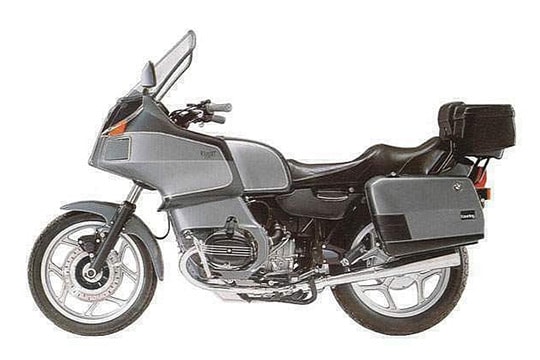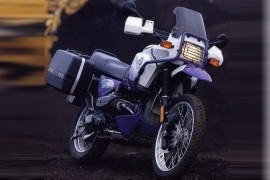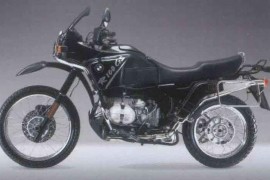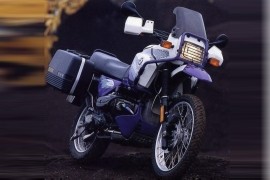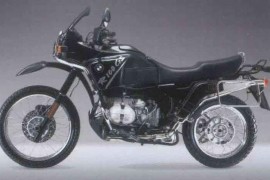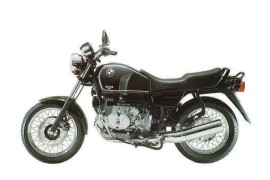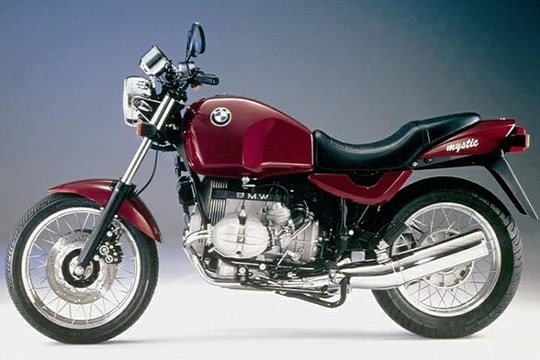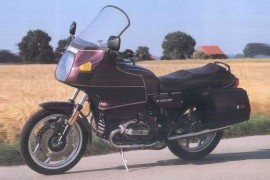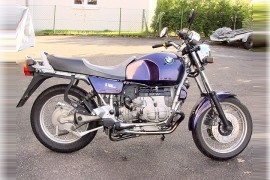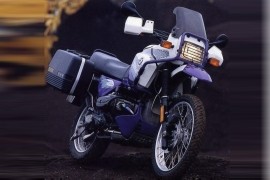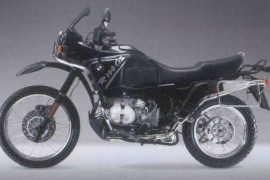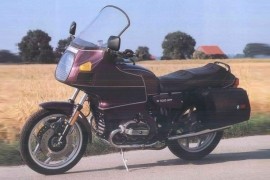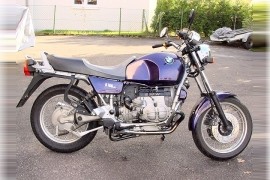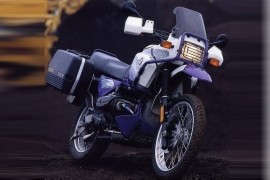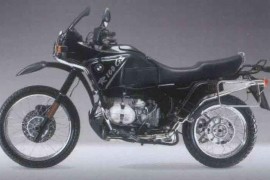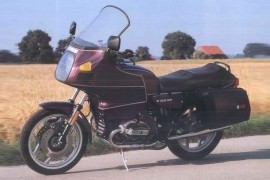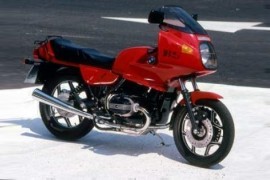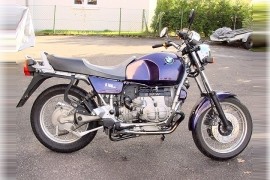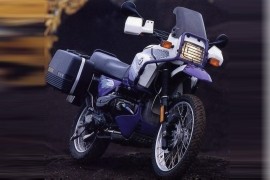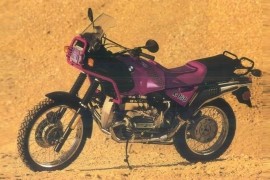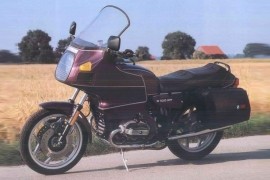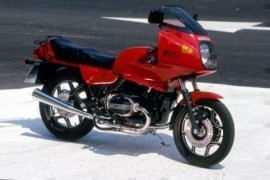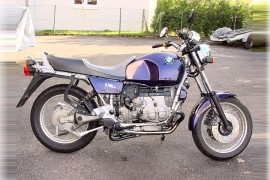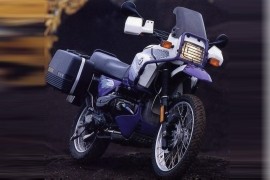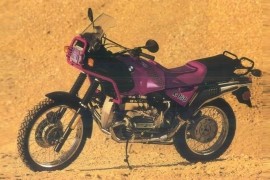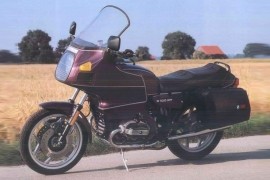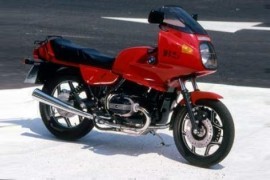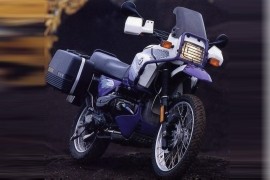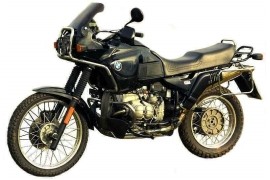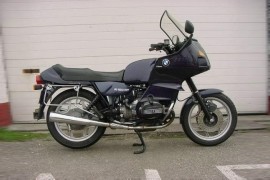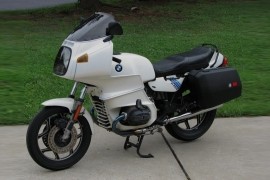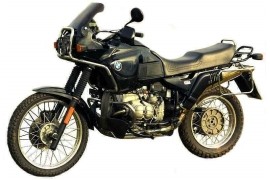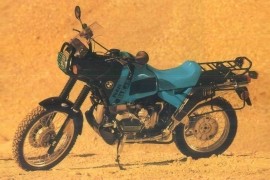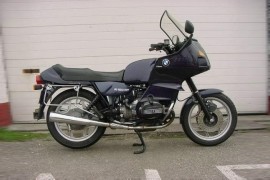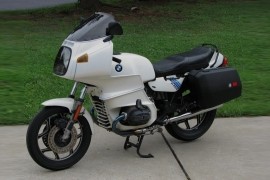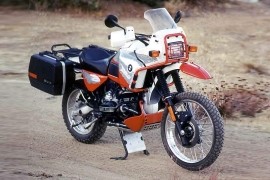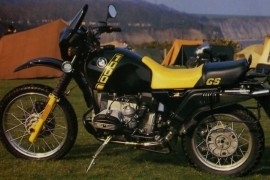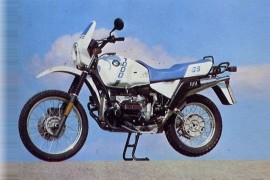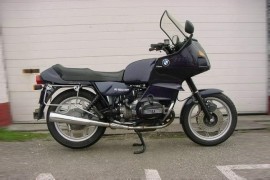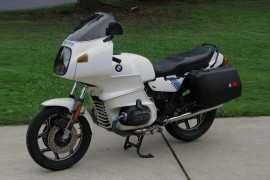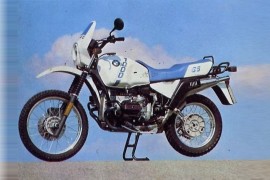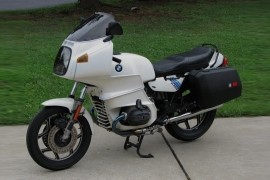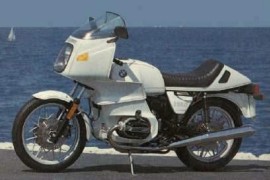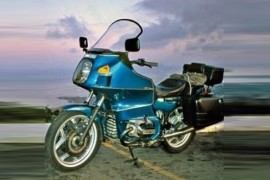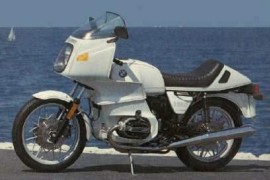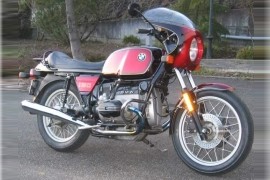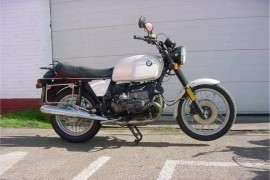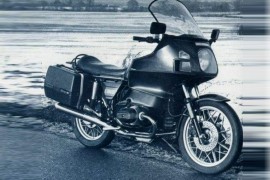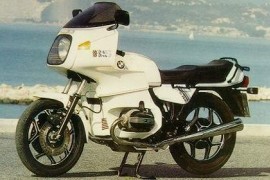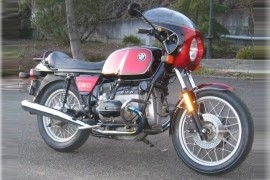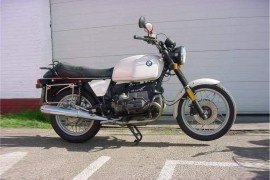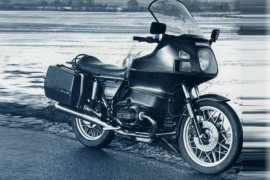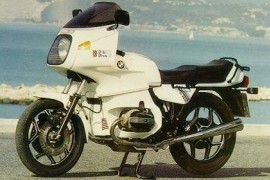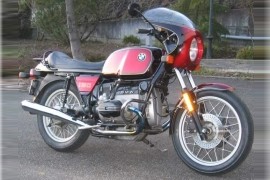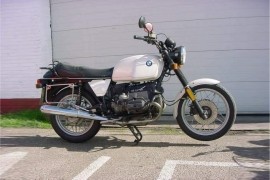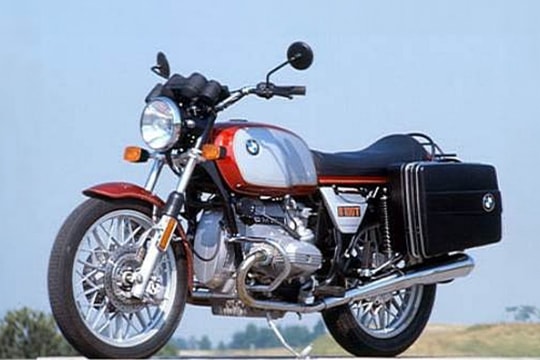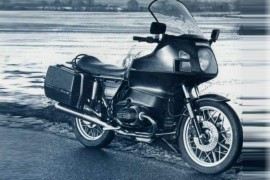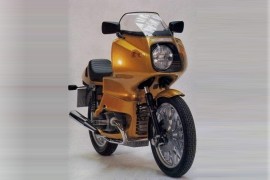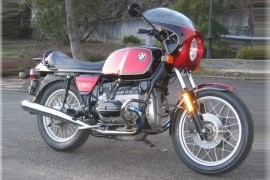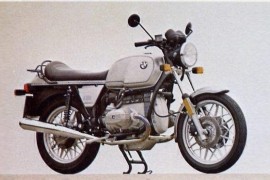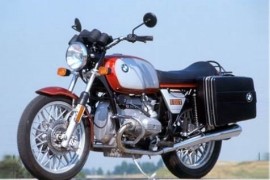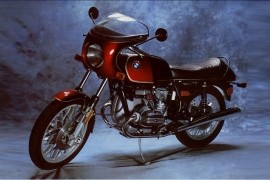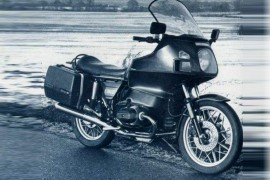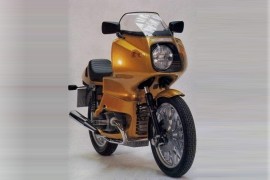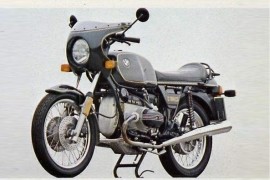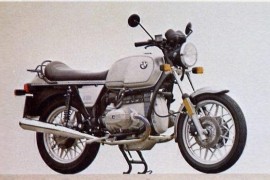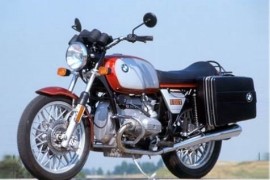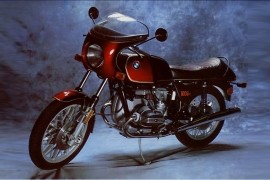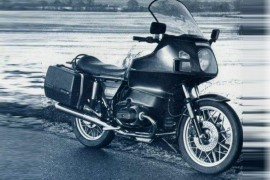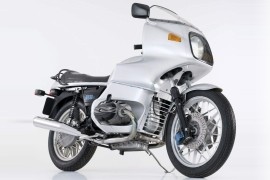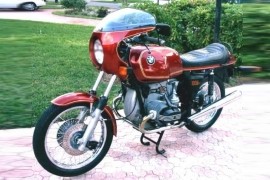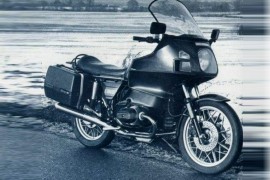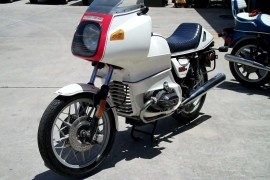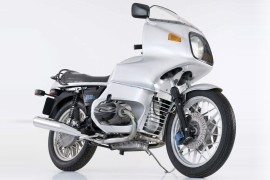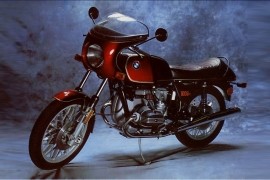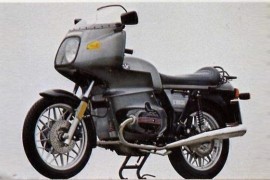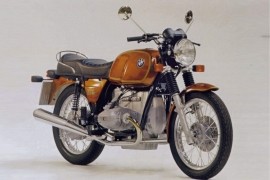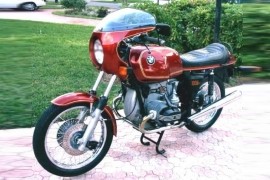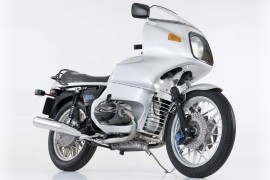BMW R 100 Models/Series Timeline, Specifications & Photos
First production year: 1975
In 1995, the German motorcycle manufacturer released the BMW R100 RT Classic, a touring-oriented version of the standard R100 RT model equipped with touring accessories.
In the visual department, the motorcycle was fitted with standard features, such as a full fairing, a tall windscreen, a one-piece dual seat with passenger grab rails, side-mounted panniers, a top box, a dual exhaust system with a silencer on each side, and eight-spoke aluminum wheels.
The 1995 BMW R100 RT Classic was powered by a 980cc four-stroke air-cooled twin-cylinder boxer engine that delivered an output power of 60 hp with a peak force at 7,000 rpm and 75 Nm (55 lb-ft) torque at 6,000 rpm.
The power generated by the engine was transmitted to a five-speed transmission with a dry single-plate clutch that sent it to the rear end via a final shaft drive, pushing the motorcycle to a top speed of 203 kph (126 mph).
For suspension, the motorcycle packed a telescopic fork with 200 mm of travel on the front and a monolever swingarm with a single shock absorber that offered 125 mm of travel on the rear.
As for the braking power, the motorcycle's wheels were fitted with two 260 mm brake discs engaged by a dual-piston caliper on the front and a 200 mm drum braking unit on the rear.
In 1995, the German motorcycle maker released the BMW R100 GS Paris Dakar, a touring-oriented motorcycle designed for riders who wanted to spend more time behind bars and explore as much as possible.
At first, the BMW R100 GS Paris Dakar was a liter-class enduro machine that debuted in 1989 as an independent machine in BMW's range. First, the maker introduced the conversion Paris Dakar Kit in 1988, with good response but low sales figures, and then the GS Paris Dakar model with the kit installed right from the factory.
The bike's aesthetic department was characterized by standard features, such as a high-mounted front fender, a front cowl with bars, a small windscreen, a one-piece dual seta with a passenger grab rail, a luggage rack, side-mounted suitcases, a center stand, and wire-spoke wheels.
In the performance department, the 1995 BMW R100 GS Paris Dakar had its soul brought to life by a 980cc four-stroke air-cooled twin-cylinder boxer engine, boasting 60 hp with a peak force at 6,500 rpm and 76 Nm (56 lb-ft) torque at 3,750 rpm.
In the suspension and braking departments, the motorcycle packed a telescopic fork with 180 mm of travel on the front end and a 285 mm brake disc with a dual-piston caliper. In contrast, the rear end was controlled by an adjustable paralever system and a 200 mm drum braking unit.
In 1995, the German motorcycle manufacturer released the BMW R100 GS, a dual-sports motorcycle built for over eight years. Although the bike was an all-road model, it performed well on paved roads but not so well in off-road situations.
The BMW R100 GS was a dual-sports motorcycle that debuted in 1987 as one of the world's largest and fastest machines at the time. The 1995 model came in the same shape and form as the previous one, providing the same specifications without any significant modifications.
The motorcycle's visual department was characterized by standard features, such as a high-mounted front fender, a small cowl with a wind deflector on the front, a round headlight, a one-piece dual seat with a passenger grab handle, a luggage rack, a center stand, and wire-spoke wheels.
All bits and pieces were mounted on a double-loop tubular steel frame, such as a telescopic fork on the front that offered 225 mm of travel and an adjustable paralever rear suspension system with 180 mm wheel travel.
The front wheel was fitted with a 285 mm brake disc and a dual-piston caliper, and the rear wheel packed a 200 mm drum braking unit, offering optimum braking power.
As for power, the 1995 BMW R100 GS took its muscles from a 980cc four-stroke air-cooled twin-cylinder boxer engine mounted underneath the fuel tank, delivering 60 hp with a peak force at 6,500 rpm and 76 Nm (56 lb-ft) torque at 6,500 rpm.
At first, the BMW R100 GS Paris Dakar was a liter-class enduro motorcycle that debuted in 1989 as an independent machine in BMW's range. First, the maker introduced the conversion Paris Dakar Kit in 1988, with good response but low sales figures, and then the GS Paris Dakar model with the kit installed right from the factory.
In 1994, the German motorcycle maker released the BMW R100 GS Paris Dakar, a touring-oriented version of the base model that featured the same specifications as the previous model without any modifications whatsoever.
In the visual department, the bike featured standard fittings, such as a high-mounted front fender, a front cowl with bars, a small windscreen, a one-piece dual seta with a passenger grab rail, a luggage rack, side-mounted suitcases, a center stand, and wire-spoke wheels.
For suspension and brakes, the motorcycle was controlled by a telescopic fork with 180 mm of travel on the front end and a 285 mm brake disc with a dual-piston caliper. In contrast, the rear end was handled by an adjustable paralever system and a 200 mm drum braking unit.
As for the power figures, the 1994 BMW R100 GS Paris Dakar boasted 60 hp with a peak force at 6,500 rpm and 76 Nm (56 lb-ft) torque at 3,750 rpm, coming from a 980cc four-stroke air-cooled twin-cylinder boxer engine, that made the motorcycle reach a top speed of 176 kph (109 mph).
The BMW R100 GS was a dual-sports motorcycle that debuted in 1987 as one of the world's largest and fastest machines at the time. Also, the bike performed well on paved roads but had limited off-road capabilities.
In 1994, the German motorcycle manufacturer released the BMW R100 GS, an all-road motorcycle in its eighth consecutive production year, wearing the same technical, visual, and performance specifications as the previous model without any changes.
The 1994 BMW R100 GS was powered by a 980cc four-stroke air-cooled twin-cylinder boxer engine mounted underneath its fuel tank, delivering an output power of 60 hp with a peak force at 6,500 rpm and 76 Nm (56 lb-ft) torque at 6,500 rpm.
The motorcycle was built around a double-loop tubular steel frame with a telescopic fork on the front that offered 225 mm of travel and an adjustable paralever rear suspension system with 180 mm of travel, providing optimum suspension performance and handling.
The braking power was achieved by a 285 mm brake disc engaged by a dual-piston caliper on the front and a 200 mm drum braking unit mounted on the rear, offering optimum stopping power.
The motorcycle's appearance was characterized by standard fittings, like a high-mounted front fender, a small cowl with a wind deflector on the front, a round headlight, a one-piece dual seat with a passenger grab handle, a luggage rack, a center stand, and wire-spoke wheels.
The BMW R100 was a naked liter-class bike that debuted in 1976 as a replacement model for the BMW/6. It was manufactured until 1996, when it was replaced by the BMW K Series.
Besides the base model, it was available in many versions with different designations, such as the R100 T, S, CS, RS, RS Classic, RT, RT Classic, TIC, TC, R, and GS. All models were powered by a 980cc twin-cylinder boxer engine.
In 1994, the German motorcycle manufacturer launched the BMW R100 R, a motorcycle without a fairing that set new standards in BMW oddness. The 1994 machine remained unchanged, packing the same specifications as the previous model without modifications.
The bike packed standard features in the aesthetic department, such as a round headlight with instruments mounted on top, a one-piece dual seat with a passenger grab rail, a luggage rack, a center stand, and wire-spoke wheels.
For suspension, the bike motorcycle was equipped with a 41 mm Showa telescopic fork on the front with 140 mm wheel travel and a side-mounted single shock absorber on the rear with 135 mm wheel travel, providing optimum suspension performance and handling.
As for the power figures, the 1994 BMW R100 R Classic had installed a 980cc four-stroke air-cooled twin-cylinder boxer engine at its core, delivering 60 hp with a peak force at 6,500 rpm and 76 Nm (56 lb-ft) torque at 6,500 rpm.
In 1993, the German motorcycle manufacturer launched the BMW R100 R Mystic, a special edition of the BMW R100 R, designed for those riders with a more nostalgic side and a taste for minimalist and simple design.
Compared to the base version, the special edition model had standard features, such as a shorter front fender, a shorter seat without passenger grab rails and luggage rack, a smaller round headlight, and wire-spoke wheels.
The motorcycle was built around a steel frame with a 41 mm Showa telescopic fork on the front and a BMW Motorrad Paralever swingarm with a single Showa monoshock on the rear, offering optimum suspension performance and handling capabilities.
As for the braking power, the motorcycle's wheels were fitted with two 285 mm discs tied to four-piston calipers on the front and a single 200 mm brake disc on the rear, providing optimum braking power.
In the performance department, the 1993 BMW R100 R Mystic had its heartbeat set by a 980cc four-stroke twin-cylinder air-cooled boxer engine that delivered an output power of 60 hp with a peak force at 6,500 rpm and 76 Nm (56 lb-ft) torque at 3,750 rpm.
A five-speed manual transmission with a dry single-plate clutch handled the engine's power, sending it to the rear wheel via a final shaft drive, pushing the motorcycle to a top speed of 175 kph (109 mph).
The BMW R100 RT Mono was one of the many versions of the base R100 model created by the House of Munich. It was a liter-class touring-oriented motorcycle that delivered comfortability and superior agility. In addition, as its name suggests, it was fitted with a BMW Motorrad Paralever system on the rear.
Besides the BMW R100 RT Mono, the standard R100 model was available in several versions with different characteristics and designations, such as the R100 T, S, CS, RS, RS Classic, RT Classic, TIC, TC, R, and GS.
In 1993, the German motorcycle manufacturer released the BMW R100 RT Mono, a touring motorcycle with the same package as the previous model, offering the same technical, performance, and visual characteristics without changes.
As for the standard features, the bike's appearance was characterized by a half fairing with a round headlight, a windscreen for better protection against elements, a one-piece dual seat, side-mounted panniers, a dual exhaust system with a silencer on each side, and eight-spoke aluminum wheels.
For suspension, the motorcycle packed a telescopic fork with a hydraulic shock absorber on the front that offered 200 mm of travel and a single-sided swingarm with a single shock absorber on the rear that provided 125 mm of travel.
As for power, the 1993 BMW R100 RT Mono had its soul brought to life by a 980cc four-stroke air-cooled twin-cylinder boxer engine, boasting 60 hp with maximum peak at 7,000 rpm and 75 Nm (55 lb-ft) torque at 6,000 rpm.
The BMW R100 was a naked liter-class bike manufactured by BMW in 1976 as a replacement model for the BMW/6. It was manufactured until 1996, when it was replaced by the BMW K Series.
It was available in many shapes and forms with different designations, such as the BMW R100 T, S, CS, RS, RS Classic, RT, RT Classic, TIC, TC, R, and GS. At its core, a 980cc twin-cylinder boxer engine delivered the power.
In 1993, the German motorcycle maker released the BMW R100 R, one of the many versions of the standard R100 model, which came without a fairing and set new standards in BMW oddness.
The 1993 BMW R100 R was powered by a 980cc four-stroke air-cooled twin-cylinder boxer engine mounted underneath its fuel tank, delivering an output power of 60 hp with a peak force at 6,500 rpm and 76 Nm (56 lb-ft) torque at 6,500 rpm.
For suspension, the bike packed a 41 mm Showa telescopic fork on the front with 140 mm of travel and a side-mounted single shock absorber on the rear with 135 mm wheel travel, providing optimum suspension performance and handling.
As for the visual department, the motorcycle was characterized by standard fittings, like a round headlight with instruments mounted on top, a one-piece dual seat with a passenger grab rail, a luggage rack, a center stand, and wire-spoke wheels.
In 1993, the German motorcycle maker released the BMW R100 GS Paris Dakar, a touring motorcycle that couldn't use the full name for copyright reasons. Because of its oversized plastic fuel tank, which was illegal in the UK, the bike was available via a grey import back door like Guernsey.
At first, the BMW R100 GS Paris Dakar was a liter-class enduro bike that debuted in 1989 as an independent machine in BMW's range. First, the maker introduced the conversion Paris Dakar Kit in 1988, with good response but low sales figures, and then the GS Paris Dakar model with the kit installed right from the factory.
The 1993 motorcycle had standard features, such as a high-mounted front fender, a front cowl with bars, a small windscreen, a one-piece dual seta with a passenger grab rail, a luggage rack, side-mounted suitcases, a center stand, and wire-spoke wheels.
In the power department, the 1993 BMW R100 GS Paris Dakar had its soul brought to life by a 980cc four-stroke air-cooled twin-cylinder boxer engine, delivering 60 hp with a peak force at 6,500 rpm and 76 Nm (56 lb-ft) torque at 3,750 rpm, launching the motorcycle to 176 kph (109 mph).
The bike packed a telescopic fork with 180 mm of travel on the front end and a 285 mm brake disc with a dual-piston caliper. In contrast, the rear end was controlled by an adjustable paralever system and a 200 mm drum braking unit.
The BMW R100 GS was an all-around motorcycle manufactured by BMW from 1987 to 1994. It was one of the world's largest and fastest dual-sports motorcycles of the time, performing well on paved roads but not as well on unpaved trails.
In 1993, the German maker released the BMW R100 GS, a powerful all-road motorcycle in its eighth consecutive production year, packing the same specifications as previous models without any major modifications.
The 1993 BMW R100 GS was powered by a 980cc four-stroke air-cooled twin-cylinder boxer engine mounted between its wheels, delivering an output power of 60 hp with a peak force at 6,500 rpm and 76 Nm (56 lb-ft) torque at 6,500 rpm.
As for the visual department, the bike was characterized by standard fittings, like a high-mounted front fender, a small front cowl with a wind deflector, a round headlight, a one-piece dual seat with a passenger grab handle, a luggage rack, a center stand, and wire-spoke wheels.
The motorcycle was manufactured around a double-loop tubular steel frame with a telescopic fork on the front that offered 225 mm of travel and an adjustable paralever rear suspension system with 180 mm wheel travel, offering optimum suspension performance and handling.
As for the braking power, the motorcycle's wheels were fitted with a 285 mm brake disc tied to a dual-piston caliper on the front and a 200 mm drum braking unit mounted on the rear, offering optimum stopping power.
In 1992, the German motorcycle manufacturer released the BMW R100 RT Mono, a touring-oriented version of the base model. It was one of many versions created by the House of Munich and received the same Monolever system as the RS Mono.
The 1992 motorcycle came in the same shape and form as the previous model, delivering the same visual, technical, and performance specifications without any major changes whatsoever.
The bike was manufactured around a steel frame with a telescopic fork on the front that offered 200 mm of travel and a single-sided swingarm with a single shock absorber on the rear that provided 125 mm of travel, handling the bike's suspension.
As for the braking performance, the bike packed two 260 mm brake discs engaged by dual-piston calipers on the front wheel and a 200 mm drum braking unit on the rear, offering optimum braking performance.
In terms of power, the 1992 BMW R100 RT Mono had its heartbeat set by a 980cc four-stroke air-cooled twin-cylinder boxer engine that delivered 60 hp with maximum peak at 7,000 rpm and 75 Nm (55 lb-ft) torque at 6,000 rpm.
In the aesthetic department, the motorcycle had standard features, such as a half fairing with a round headlight, a windscreen for better protection against elements, a one-piece dual seat, side-mounted panniers, a dual exhaust system with a muffler mounted on each side, and eight-spoke aluminum wheels.
The BMW R100 RS Mono was a fully-faired touring motorcycle produced by BMW in 1987. It was addressed to riders who wanted more power from their machine and a boxer engine's unmistakable sound and feel.
In 1992, the German motorcycle maker released the BMW R100 RS Mono, a liter-class touring motorcycle in its sixth consecutive production year, wearing the same specifications as previous ones without any changes.
Underneath its fuel tank, the 1992 BMW R100 RS Mono had installed a 980cc four-stroke twin-cylinder air-cooled boxer engine that delivered an output power of 60 hp with a peak force at 6,500 rpm and 75 Nm (55 lb-ft) torque at 3,500 rpm.
The bike's suspension system comprised a hydraulic telescopic fork on the front and a BMW Motorrad Monolever system on the rear, providing optimum suspension performance and handling capabilities.
In the braking department, the bike packed two 285 mm braking discs engaged by dual-piston calipers on the front and a 200 mm drum braking unit on the rear, providing optimum stopping power.
As for the visual department, the motorcycle was characterized by standard features, such as a full fairing, a round headlight integrated into the fairing, a windscreen, a one-piece dual seat with a passenger grab handle, a dual chromed exhaust system with a muffler on each side, a center stand, and eight-spoke alloy wheels.
The BMW R100 was a naked motorcycle made by BMW in 1976 as a replacement model for the BMW/6 and manufactured until 1996, when it was replaced by the BMW K Series.
The BMW R100 standard model was available in many versions with different characteristics and designations, such as T, S, CS, RS, RS Classic, RT, RT Classic, TIC, TC, R, and GS.
The BMW R100 R was one of many versions of the base model. It came without a fairing, set new standards in BMW oddness, and was powered by a 980cc four-stroke twin-cylinder boxer engine.
In 1992, the German motorcycle manufacturer launched the BMW R100 R, a naked motorcycle with the same package as previous models without significant modifications.
The bike packed standard features such as a round headlight with instruments mounted on top, a one-piece dual seat with a passenger grab rail, a luggage rack, a center stand, and wire-spoke wheels.
The bike's suspension was handled by a 41 mm Showa telescopic fork on the front with 140 mm of travel and a side-mounted single shock absorber on the rear with 135 mm of travel, offering optimum suspension performance and handling.
As for power, the 1992 BMW R100 R had installed a 980cc four-stroke air-cooled twin-cylinder boxer engine mounted underneath its fuel tank, boasting 60 hp with a peak force at 6,500 rpm and 76 Nm (56 lb-ft) torque at 6,500 rpm.
The BMW R100 GS was a dual-sports motorcycle manufactured by BMW from 1987 to 1994. It was one of the world's largest and fastest all-road bikes of the time, performing well on paved roads but not as well on unpaved trails.
In addition to the standard R100 GS, the maker introduced the 1989 BMW R100 GS Paris Dakar, an enduro motorcycle fitted right from the box with a Paris Dakar Kit.
At first, the BMW R100 GS Paris Dakar was a liter-class enduro bike that debuted in 1989 as an independent motorcycle in BMW's range. First, the maker introduced the conversion Paris Dakar Kit in 1988, with good response but low sales figures, and then the GS Paris Dakar model with the kit installed right from the factory.
In 1992, the German motorcycle manufacturer released the BMW R100 GS Dakar, a motorcycle in its fourth consecutive production year that suited the more adventurous among Beemer fans.
The bike came with the same package as previous models, delivering the same performance, technical, and visual specifications without any significant modifications whatsoever.
In the visual department, the motorcycle was characterized by standard features, such as a high-mounted front fender, a front cowl with bars, a small windscreen, a one-piece dual seta with a passenger grab rail, a luggage rack, side-mounted suitcases, a center stand, and wire-spoke wheels.
As for power, the 1992 BMW R100 GS Paris Dakar took its muscles from a 980cc four-stroke air-cooled twin-cylinder boxer engine, boasting 60 hp with a peak force at 6,500 rpm and 76 Nm (56 lb-ft) torque at 3,750 rpm, launching the motorcycle to 176 kph (109 mph).
The BMW R100 GS was a dual-sports machine produced by BMW from 1987 to 1994. It was one of the world's largest and fastest all-road bikes of the time, performing well on paved roads but not as well off the road.
In 1992, the German motorcycle maker introduced the BMW R100 GS, a dual-sports motorcycle, in its sixth consecutive production year. It came with the same specifications as previous models without any modifications.
The 1992 BMW R100 GS had its soul brought to life by a 980cc four-stroke air-cooled twin-cylinder boxer engine mounted underneath its fuel tank, delivering an output power of 60 hp with a peak force at 6,500 rpm and 76 Nm (56 lb-ft) torque at 6,500 rpm.
The bike's riding experience was handled by a telescopic fork on the front that provided 225 mm of travel and an adjustable paralever rear suspension with 180 mm of travel, offering optimum suspension performance and handling.
As for the braking power, the motorcycle packed a 285 mm brake disc tied to a dual-piston caliper on the front and a 200 mm drum braking unit mounted on the rear, offering optimum stopping power.
The bike's visual department was characterized by standard fittings, like a high-mounted front fender, a small front cowl with a wind deflector, a round headlight, a one-piece dual seat with a passenger grab handle, a luggage rack, a center stand, and wire-spoke wheels.
In 1991, the German motorcycle maker released the BMW R100 RT Mono, a more touring-oriented version of the base model that addressed touring riders. It received the same treatment as the RS Mono, which included a BMW Motorrad Monolever system on the rear.
In addition to the R100 RT Mono, the base R100 was offered in many versions with different designations, such as the R100 T, S, CS, RS, RS Classic, RT, RT Classic, TIC, TC, R, and GS.
The 1991 R100 RT Mono was identical to the previous model, packing the same technical, visual, and performance specifications without any significant modifications whatsoever.
The bike was fitted right from the box with standard features, such as a half fairing with a round headlight, a windscreen for better protection against elements, a one-piece dual seat, side-mounted panniers, a dual exhaust system with a silencer on each side, and eight-spoke aluminum wheels.
The bike's suspension system comprised a telescopic fork with a hydraulic shock absorber on the front that offered 200 mm of travel and a single-sided swingarm with a single shock absorber on the rear that provided 125 mm of travel.
The braking power was handled by two 260 mm brake discs coupled to dual-piston calipers on the front wheel and a 200 mm drum braking unit mounted on the rear, providing optimum braking performance.
As for power, the 1991 BMW R100 RT Mono took its muscles from a 980cc four-stroke air-cooled twin-cylinder boxer engine that delivered 60 hp with maximum strength at 7,000 rpm and 75 Nm (55 lb-ft) torque at 6,000 rpm.
The BMW R100 RS Mono was a fully-faired motorcycle that debuted in 1987. As its name suggests, the R100 RS Mono came with a BMW Motorrad Monolever suspension on the rear. It suited riders who wanted more power from their machine and a boxer engine's unmistakable sound and feel.
In 1991, the German motorcycle manufacturer launched the BMW R100 RS Mono, a motorcycle in its fifth consecutive production year. In addition, the bike came with the same package as the previous model without any changes whatsoever.
The motorcycle had standard features in the visual department, including a full fairing, a round headlight integrated into the fairing, a windscreen, a one-piece dual seat with a passenger grab handle, a dual chromed exhaust system with a muffler on each side, a center stand, and eight-spoke alloy wheels.
For suspension, the motorcycle packed a hydraulic telescopic fork on the front and a BMW Motorrad Monolever system on the rear, providing optimum suspension performance and handling capabilities.
As for the braking power, the motorcycle's wheels were fitted with two 285 mm braking discs tied to dual-piston calipers on the front and a 200 mm drum braking unit on the rear, providing optimum stopping power.
The 1991 BMW R100 RS Mono had its soul brought to life by a 980cc four-stroke twin-cylinder air-cooled boxer engine, boasting 60 hp at 6,500 rpm and 75 Nm (55 lb-ft) torque at 3,500 rpm.
The BMW R100 was a naked motorcycle manufactured by BMW from 1976 as a replacement model for the BMW/6 and produced until 1996 when it was replaced by the BMW K Series.
In addition, the R100 was available in several versions with different designations, like the T, S, CS, RS, RS Classic, RT, RT Classic, TIC, TC, R, and GS. The bikes were powered by a 980cc four-stroke twin-cylinder boxer engine.
In 1991, the German motorcycle maker released the BMW R100 R, one of the many versions of the standard R100 model. It came without a fairing and set new standards in BMW oddness.
In the visual department, the motorcycle had standard fittings, such as a round headlight with instruments mounted on top, a one-piece dual seat with a passenger grab rail, a luggage rack, a center stand, and wire-spoke wheels.
For suspension, the motorcycle packed a 41 mm Showa telescopic fork on the front with 140 mm of travel and a side-mounted single shock absorber on the rear with 135 mm of travel, offering optimum suspension performance and handling.
As for the power figures, the 1991 BMW R100 R had installed a 980cc four-stroke air-cooled twin-cylinder boxer engine underneath its fuel tank, boasting 60 hp with a peak force at 6,500 rpm and 76 Nm (56 lb-ft) torque at 6,500 rpm.
The BMW R100 GS was a dual-sports motorcycle manufactured by BMW from 1987 to 1994. It was one of the world's largest and fastest all-road bikes of the time, performing well on paved roads but not as well on unpaved trails.
In 1991, the German motorcycle manufacturer launched the BMW R100 GS Paris Dakar, an enduro machine that featured the conversion kit right from the box. It came with the same package as the previous model without any significant changes.
At first, the BMW R100 GS Paris Dakar was a liter-class enduro bike that debuted in 1989 as an independent model in the range. First, the maker introduced the conversion Paris Dakar Kit in 1988, with good response but low sales figures, and then the GS Paris Dakar model with the kit installed right from the factory.
In the visual department, the motorcycle had standard features, like a high-mounted front fender, a front cowl with bars, a small windscreen, a one-piece dual seta with a passenger grab rail, a luggage rack, side-mounted suitcases, a center stand, and wire-spoke wheels.
As for the power figures, the 1991 BMW R100 GS Paris Dakar took its muscles from a 980cc four-stroke air-cooled twin-cylinder boxer engine, boasting 60 hp with a peak force at 6,500 rpm and 76 Nm (56 lb-ft) torque at 3,750 rpm, launching the motorcycle to 176 kph (109 mph).
The BMW R100 GS was an all-around motorcycle produced by BMW from 1987 to 1994. It was one of the world's largest and fastest dual-sports bikes of the time, performing well on paved roads but not as well on unpaved trails.
In 1991, the German motorcycle maker released the BMW R100 GS, a dual-sports motorcycle, in its fifth consecutive production year. It came with the same package as the previous model without any modifications.
In the visual department, the motorcycle had standard fittings, like a high-mounted front fender, a small front cowl with a wind deflector, a round headlight, a one-piece dual seat with a passenger grab handle, a luggage rack, a center stand, and wire-spoke wheels.
The bike's double-loop tubular steel frame was paired with a telescopic fork on the front that provided 225 mm of travel and an adjustable paralever rear suspension system with 180 mm of travel, offering optimum suspension performance and handling.
In the braking department, the motorcycle's wheels were fitted with a 285 mm brake disc tied to a dual-piston caliper on the front and a 200 mm drum braking unit mounted on the rear, offering optimum stopping power.
The 1991 BMW R100 GS took its muscles from a 980cc four-stroke air-cooled twin-cylinder boxer engine mounted at its core, boasting an output power of 60 hp with a peak force at 6,500 rpm and 76 Nm (56 lb-ft) torque at 6,500 rpm.
The 1990 BMW R100 RT Mono was virtually unchanged from previous models, featuring the same technical, visual, and performance specifications without any significant modifications.
The BMW R100 RT Mono was one of many versions of the base R100 model created by the House of Munich, receiving the same treatment as the RS Mono, which consisted of a BMW Motorrad Monolever swingarm.
In the visual department, the motorcycle had standard features, such as a half fairing with a round headlight, a windscreen for better protection against elements, a one-piece dual seat, side-mounted panniers, a dual exhaust system with a silencer on each side, and eight-spoke aluminum wheels.
In the performance department, the 1990 BMW R100 RT Mono had its soul brought to life by a 980cc four-stroke air-cooled twin-cylinder boxer engine that delivered 60 hp with maximum strength at 7,000 rpm and 75 Nm (55 lb-ft) torque at 6,000 rpm.
The bike was built around a steel frame that housed the suspension system. It comprised a telescopic fork with a hydraulic shock absorber on the front that offered 200 mm of travel and a single-sided swingarm with a single shock absorber on the rear that provided 125 mm of travel.
As for the stopping power, the bike's wheels were fitted with two 260 mm brake discs engaged by dual-piston calipers on the front wheel and a 200 mm drum braking unit on the rear, providing optimum braking performance.
In 1990, the German motorcycle manufacturer launched the BMW R100 RS Mono, a touring motorcycle that featured, as its name suggests, a BMW Motorrad Monolever system on the rear.
The 1990 BMW R100 RS Mono was a fully faired touring motorcycle introduced by BMW in 1987, addressed to riders who wanted more power from their machine and the unmistakable sound and feel of a boxer engine.
The 1990 model was in its fourth consecutive year of production, featuring the same package as previous models. It delivered the same technical, visual, and performance specifications without modifications.
Its aesthetic department was characterized by standard features, including a full fairing, a round headlight integrated into the fairing, a windscreen, a one-piece dual seat with a passenger grab handle, a dual chromed exhaust system with a muffler on each side, a center stand, and eight-spoke alloy wheels.
In the suspension department, the bike packed a hydraulic telescopic fork on the front and a BMW Motorrad Monolever system on the rear, providing optimum suspension performance and handling.
Braking-wise, the bike's wheels were fitted with two 285 mm braking discs tied to dual-piston calipers on the front and a 200 mm drum braking unit on the rear.
As for the power figures, the engine boasted 60 hp at 6,500 rpm and 75 Nm (55 lb-ft) torque at 3,500 rpm from a 980cc four-stroke twin-cylinder air-cooled boxer engine mounted underneath its fuel tank.
In 1991, in addition to the successful revision of the Paralever GS models, BMW prepared a surprise for boxer fans and tried to reproduce the success on a street version motorcycle. The 1991 BMW R 100 R received a naked bike look with classic style elements.
The bike featured cross-spoked rims, a two-in-one exhaust system with chrome-plated rear mufflers, a 200 mm round chrome-plated headlight, and handlebar fittings originated from the K series.
The bike's trust came from the 980cc flat-twin engine with a power output of 60 hp at 6,500 rpm and 76 Nm (56 lb-ft) of torque with a peak at 6,500 rpm. The engine power, combined with a five-speed manual transmission and a 218 kg (481 lbs) curb weight, managed to send the bike to a top speed of 181 kph (115 mph).
The up-to-date braking technology consisted of a 285 mm floating disc brake from the GS with a four-piston caliper which originated from the BMW K series (optional 285 mm double disc) on the front wheel and a 200 mm drum braking unit on the rear wheel.
For suspension, the model packed a telescopic fork with hydraulic shock absorbers on the front and a BMW Paralever single-sided swingarm with a central spring strut on the rear.
The BMW R100 GS Paris Dakar was a liter-class enduro motorcycle that debuted in 1989 as an independent model in the range. First, the maker introduced the conversion Paris Dakar Kit in 1988, with a good response but low sales figures.
In 1990, the German motorcycle manufacturer launched the BMW R100 GS Paris Dakar, an enduro motorcycle that featured the conversion kit right from the box. It came with the same package as the previous model without any significant changes.
The bike's aesthetic department was characterized by standard features, such as a high-mounted front fender, a front cowl with bars, a small windscreen, a one-piece dual seta with a passenger grab rail, a luggage rack, side-mounted suitcases, a center stand, and wire-spoke wheels.
As for suspension, the motorcycle packed a hydraulic telescopic fork on the front with 225 mm wheel travel and an adjustable paralever system on the rear with 180 mm wheel travel, providing optimum suspension performance and handling.
In the power department, the 1990 BMW R100 GS Paris Dakar had installed a 980cc four-stroke air-cooled twin-cylinder boxer engine, boasting 60 hp with a peak force at 6,500 rpm and 76 Nm (56 lb-ft) torque at 3,750 rpm.
The power was handled by a five-speed transmission that sent it to the rear wheel through a final shaft drive, pushing the motorcycle to a top speed of 176 kph (109 mph).
The BMW R100 GS was a dual-sports liter-class motorcycle created by the House of Munich in 1987 and manufactured until 1994. Although the bike handled the paved roads well, it had light off-road capabilities.
In 1990, the German motorcycle manufacturer launched the BMW R100 GS, which came in the same shape and form as the previous model, providing the same technical, visual, and performance specifications without any changes.
The 1990 BMW R100 GS was powered by a 980cc four-stroke air-cooled twin-cylinder boxer engine mounted underneath its fuel tank, delivering an output power of 60 hp with a peak force at 6,500 rpm and 76 Nm (56 lb-ft) torque at 6,500 rpm.
It was built around a double-loop tubular steel frame, offering mounting points for its suspension system. It comprised a telescopic fork on the front that provided 225 mm of travel and an adjustable paralever rear suspension system with 180 mm of travel.
As for the braking power, the bike's wheels were fitted with a 285 mm brake disc tied to a dual-piston caliper on the front and a 200 mm drum braking unit mounted on the rear, offering optimum stopping power.
The bike's visual department was characterized by standard fittings, like a high-mounted front fender, a small front cowl with a wind deflector, a round headlight, a one-piece dual seat with a passenger grab handle, a luggage rack, a center stand, and wire-spoke wheels.
In 1989, the German motorcycle manufacturer launched the BMW R100 RT Mono, one of many versions of the base R100 model created by the House of Munich. The RT Mono received the same treatment as the RS Mono, featuring a BMW Motorrad Monolever swingarm.
The 1989 RT Mono model came with the same package as previous models, featuring the same technical, visual, and performance specifications without any significant modifications whatsoever.
It packed the same standard features as previous ones, including a half fairing with a round headlight, a windscreen for better protection against elements, a one-piece dual seat, side-mounted panniers, a dual exhaust system with a silencer on each side, and eight-spoke aluminum wheels.
It was built around a steel frame that housed the suspension system. It comprised a telescopic fork with a hydraulic shock absorber on the front that offered 200 mm of travel and a single-sided swingarm with a single shock absorber on the rear that provided 125 mm of travel.
As for the braking power, the machine packed two 260 mm brake discs engaged by dual-piston calipers on the front wheel and a 200 mm drum braking unit on the rear, providing optimum stopping power.
Power-wise, the 1989 BMW R100 RT Mono had its heartbeat set by a 980cc four-stroke air-cooled twin-cylinder boxer engine that delivered 60 hp with maximum strength at 7,000 rpm and 75 Nm (55 lb-ft) torque at 6,000 rpm.
The BMW R100 RS Mono was a fully faired touring motorcycle introduced by BMW in 1987, packing, as its name suggests, a monolever suspension system on the rear represented by a single-sided swingarm coupled to a single-sided rear shock absorber.
In 1989, the German motorcycle manufacturer launched the BMW R100 RS Mono, a touring motorcycle addressed to riders who wanted more power from their machine and the unmistakable sound and feel of a boxer engine.
The 1989 motorcycle was delivered with the same package as previous models, offering the same technical, visual, and performance specifications without any significant modifications whatsoever.
In the visual department, the bike had standard fittings, such as a full fairing, a round headlight integrated into the fairing, a windscreen, a one-piece dual seat with a passenger grab handle, a dual chromed exhaust system with a muffler on each side, a center stand, and eight-spoke alloy wheels.
In terms of power, the 1989 BMW R100 RS Mono took its muscles from a 980cc four-stroke twin-cylinder air-cooled boxer engine mounted underneath its fuel tank, boasting 60 hp at 6,500 rpm and 75 Nm (55 lb-ft) torque at 3,500 rpm.
As for safety, the bike's eight-spoke aluminum wheels were fitted with two 285 mm brake discs on the front, dual-piston calipers, and a 200 mm drum braking unit mounted on the rear, offering optimum braking performance.
In 1988, the German bike maker introduced a new conversion Paris Dakar Kit for the BMW R80 and BMW R100 GS models. It had a good response but didn't meet the required sales figures.
One year later, in 1989, when the demand for conversion elements grew, the German motorcycle maker introduced the BMW R100 GS Paris Dakar, an independent model in the range fitted with a conversion kit right from the box.
The 1989 Paris Dakar version was fitted with a large 35-liter (8.1-gallon) fuel tank with a glove compartment, a front fairing with all-around tubular bars, a rectangular headlight, and a small windscreen.
The model also included a single seat with an extension for the luggage rack, and as a shield from debris, it packed a wider and higher front fender, an engine spoiler, and a headlight grille. It also came with wire-spoke wheels shod in off-road tires, an analog instrument panel, and an under-seat exhaust system.
The 1989 BMW R100 GS Paris Dakar had its soul brought to life by a 980cc four-stroke air-cooled twin-cylinder boxer engine that delivered an output power of 60 hp at 6,500 rpm and 76 Nm (56 lb-ft) torque at 3,750 rpm.
The power produced by the engine was converted into motion by a five-speed transmission and sent to the rear axle via a final shaft drive, pushing the motorcycle to a maximum speed of 181 kph (112 mph).
The BMW R100 GS was a dual-sports motorcycle manufactured by BMW from 1987 to 1994. It was one of the world's largest and fastest all-road bikes of the time, performing well on paved roads but not as well on unpaved trails.
In 1989, the German motorcycle manufacturer released the BMW R100 GS, a dual sports machine with the same package as previous models without any significant modifications whatsoever.
The bike was manufactured around a double-loop tubular steel frame. Its suspension system comprised a telescopic fork on the front that provided 225 mm of travel and an adjustable paralever rear suspension system with 180 mm of travel.
The bike's braking system consisted of a 285 mm brake disc coupled to a dual-piston caliper on the front and a 200 mm drum braking unit mounted on the rear, offering optimum stopping power.
In the performance department, the 1989 BMW R100 GS had installed a 980cc four-stroke air-cooled twin-cylinder boxer engine underneath its fuel tank, delivering an output power of 60 hp with a peak force at 6,500 rpm and 76 Nm (56 lb-ft) torque at 6,500 rpm.
The bike's aesthetic department was characterized by standard features, such as a high-mounted front fender, a small front cowl with a wind deflector, a round headlight, a one-piece dual seat with a passenger grab handle, a luggage rack, a center stand, and wire-spoke wheels.
In 1988, the German bike maker released the BMW R100 RT Mono, one of many versions of the standard R100 models the House of Munich created. As its name suggests, the bike was fitted with a BMW Motorrad Monolever suspension system on the rear.
The 1988 R100 RT Mono was offered in the same shape and form as the previous one, providing the same visual, technical, and performance specifications without any significant modifications.
The bike's suspension system comprised a telescopic fork with a hydraulic shock absorber on the front that delivered 200 mm of travel and a single-sided swingarm with a single shock absorber on the rear that offered 125 mm of travel.
In the safety department, the motorcycle relied on two 260 mm brake discs tied to dual-piston calipers on the front wheel and a 200 mm drum braking unit on the rear, providing optimum stopping power.
Standard fittings, like a half fairing with a round headlight, a tall windscreen for better protection against wind and elements, a one-piece dual seat with a passenger grab rail, side-mounted panniers, a dual exhaust system with a silencer on each side, and eight-spoke aluminum wheels characterized the bike's aesthetic department.
In terms of power, the 1988 BMW R100 RT Mono had installed a 980cc four-stroke twin-cylinder air-cooled boxer engine at its core, boasting 60 hp with a peak force at 7,000 rpm and 75 Nm (55 lb-ft) torque at 6,000 rpm.
In 1988, the German motorcycle maker released the BMW R100 RS Mono, a touring machine for touring riders who wanted more power but also the unmistakable sound and feel of a boxer powerhouse.
The 1988 model came in the same shape and form as the previous one, delivering the same visual, technical, and performance specifications without any significant changes whatsoever.
It packed the same standard features as the previous model, like a full fairing, a round headlight integrated into the fairing, a windscreen, a one-piece dual seat with a passenger grab handle, a dual chromed exhaust system with a muffler on each side, a center stand, and eight-spoke alloy wheels.
Suspension-wise, the bike was fitted with a telescopic fork on the front that provided 275 mm of travel and a single-sided swingarm with a right-hand side-mounted shock absorber that offered 121 mm of travel.
The bike's eight-spoke alloy wheels were fitted with two 285 mm brake discs on the front, dual-piston calipers, and a 200 mm drum braking unit mounted on the rear, offering optimum braking performance.
As for the power figures, the 1988 BMW R100 RS Mono took its muscles from a 980cc four-stroke twin-cylinder air-cooled boxer engine, delivering an output power of 60 hp at 6,500 rpm and 75 Nm (55 lb-ft) torque at 3,500 rpm. All the power was concentrated on the rear wheel, pushing the bike to 189 kph (117 mph).
In 1988, the German motorcycle manufacturer released the BMW R100 GS, one of the world's largest and fastest off-road bikes at the time. The bike performed well on paved roads but not as well on unpaved trails.
The R100 GS debuted in 1987 and was manufactured until 1994. In addition, the 1988 model came in the same shape and form as the previous one without any significant modifications.
All bits and pieces were bolted on a double-loop tubular steel frame with a telescopic fork that handled the front suspension, providing 225 mm of travel and an adjustable paralever rear suspension system with 180 mm of travel.
As for the braking power, the bike relied on a 285 mm brake disc coupled to a dual-piston caliper on the front and a 200 mm drum braking unit mounted on the rear, offering optimum stopping power.
The visual department was characterized by standard features, such as a high-mounted front fender, a small front cowl with a wind deflector, a round headlight, a one-piece dual seat with a passenger grab handle, a luggage rack, a center stand, and wire-spoke wheels.
As for the power figures, the 1988 BMW R100 GS had its heartbeat set by a 980cc four-stroke air-cooled twin-cylinder boxer engine mounted between the wheels, delivering 60 hp with a peak force at 6,500 rpm and 76 Nm (56 lb-ft) torque at 6,500 rpm.
In 1988, BMW supplied a new Paris-Dakar Kit as a professional conversion kit for the R 80 GS and R 100 GS models, which had a good response but not with enough sales figures. In 1989, when the demand for conversion elements started to grow, BMW introduced the R 100 GS Paris-Dakar model as an independent product in the range equipped with a full conversion kit right from the factory.
At a first sight, the 1989 BMW R 100 GS Paris-Dakar caught the eye with a big 35-liter (8.1-gallon) tank with a glove compartment, a front fairing with all-around tubular bars, rectangular headlights, and a windshield.
The model included a single seat with an extension for the luggage rack, and as a shield from debris, it packed a wider and higher front fender, an engine spoiler, and a headlight grille. It also came with laced wheels dressed in off-road tires, an analog instrument panel, and an under-seat exhaust system.
The trust came from the 980cc flat-twin engine with a power output of 60 hp with a peak at 6,500 rpm and 76 Nm (56 lb-ft) of torque available at 6,500 rpm. In conjunction with a five-speed manual transmission and a curb weight of 236 kg (520 lbs), the bike reached a top speed of 180 kph (112 mph).
The BMW R100 RT Mono was one of many versions of the base R100 model created by the House of Munich. The 1987 R100 RT Mono received the same treatment as the RS Mono, which consisted of a BMW Motorrad Monolever swingarm.
In 1987, the German motorcycle manufacturer launched the BMW R100 RT Mono, a touring motorcycle that packed a single-sided swingarm, as its name suggests, and touring accessories.
In the visual department, the bike had standard fittings, such as a half fairing with a round headlight, a windscreen for better protection against elements, a one-piece dual seat, side-mounted panniers, a dual exhaust system with a silencer on each side, and eight-spoke aluminum wheels.
Suspension-wise, the motorcycle featured a telescopic fork with a hydraulic shock absorber on the front that delivered 200 mm of travel and a single-sided swingarm with a single shock absorber on the rear that offered 125 mm of travel.
As for the braking performance, the motorcycle packed two 260 mm brake discs coupled to dual-piston calipers on the front wheel and a 200 mm drum braking unit on the rear, providing optimum stopping power.
As for power, the 1987 BMW R100 RT Mono had its heartbeat set by a 980cc four-stroke air-cooled twin-cylinder boxer engine that delivered an output power of 60 hp with maximum strength at 7,000 rpm and 75 Nm (55 lb-ft) torque at 6,000 rpm.
In 1987, the German motorcycle manufacturer launched the BMW R100 RS Mono, a touring motorcycle that featured the monolever swingarm introduced in 1986. The 1987 model packed the same specifications as the previous model without modifications.
In the visual department, the bike packed standard fittings, such as a full fairing, a round headlight integrated into the fairing, a windscreen, a one-piece dual seat with a passenger grab handle, a dual chromed exhaust system with a muffler on each side, a center stand, and eight-spoke alloy wheels.
At its core, the 1987 BMW R100 RS Mono had installed a 980cc four-stroke twin-cylinder air-cooled boxer engine fed by two Bing carburetors, delivering an output power of 60 hp at 6,500 rpm and 75 Nm (55 lb-ft) torque at 3,500 rpm.
All the power generated by the engine was converted into motion by a five-speed manual transmission with a dry single-plate clutch that redirected it to the rear end via a final shaft drive, pushing the motorcycle to 189 kph (117 mph).
For suspension, the motorcycle was fitted with a telescopic fork on the front that provided 275 mm of travel and a single-sided swingarm with a right-hand side-mounted shock absorber that offered 121 mm of travel.
As for the braking power, the BMW R100 RS Mono's wheels were fitted with two 285 mm brake discs on the front with dual-piston calipers and a 200 mm drum braking unit mounted on the rear, offering optimum braking performance.
The 1988 MY BMW R 100 GS Paris Dakar has been specially equipped for endurance enduro racing, and comes with features such as a single seat, side panniers, a large luggage rack, wide handlebars, a small windscreen, a front mud-guard, laced wheels with off-road tires mounted on them and a large-capacity, 35-liter (8.1-gallon) fuel tank.
In all other departments it has the same features as the base R 100 GS. Power-wise, it can reach a maximum power output of 60 horsepower and 76 Nm of torque.
In 1987, alongside the standard R100 GS model, the maker introduced the BMW R100 GS Bumble Bee, a unique edition motorcycle created by the House of Munich with a striking black and yellow color scheme. Other than that, the bike boasted the same specs as the base model.
The BMW R100 GS was one of the world's largest and fastest off-road bikes at the time. The bike performed well on paved roads but could have performed better on off-roads. In addition, the motorcycle debuted in 1987 and was produced until 1994.
The motorcycle packed a double-loop tubular steel frame with a telescopic fork on the front that provided 225 mm of travel and an adjustable paralever rear suspension system with 180 mm of travel, offering optimum suspension performance and handling capabilities.
As for the braking power, the bike relied on a 285 mm brake disc coupled to a dual-piston caliper on the front and a 200 mm drum braking unit mounted on the rear, providing optimum stopping power.
In the visual department, the bike had standard features, such as a high-mounted front fender, a small front cowl with a wind deflector, a round headlight, a one-piece dual seat with a passenger grab handle, a luggage rack, a center stand, and wire-spoke wheels.
As for power, the 1987 BMW R100 GS Bumble Bee had its soul brought to life by a 980cc four-stroke air-cooled twin-cylinder boxer engine, boasting 60 hp with a peak force at 6,500 rpm and 76 Nm (56 lb-ft) torque at 6,500 rpm.
In 1987, the German motorcycle manufacturer launched the BMW R100 GS, a dual-sports motorcycle and one of the world's largest and fastest off-road bikes at the time. The bike performed well on paved roads but could have performed better on off-roads. In addition, the motorcycle debuted in 1987 and was produced until 1994.
The bike's visual department was characterized by standard features, such as a high-mounted front fender, a small front cowl with a wind deflector, a round headlight, a one-piece dual seat with a passenger grab handle, a luggage rack, a center stand, and wire-spoke wheels.
The bike was built around a double-loop tubular steel frame with a telescopic fork on the front that provided 225 mm of travel and an adjustable paralever rear suspension system with 180 mm of travel.
In the braking department, the bike's wire-spoke wheels were fitted with a 285 mm brake disc coupled to a dual-piston caliper on the front and a 200 mm drum braking unit mounted on the rear.
As for power, the 1987 BMW R100 GS had installed a 980cc four-stroke air-cooled twin-cylinder boxer engine with two Bing carburetors in charge, boasting 60 hp with a peak force at 6,500 rpm and 76 Nm (56 lb-ft) torque at 6,500 rpm.
The power generated by the engine was converted into motion by a five-speed gearbox that sent it to the rear end through a final shaft drive, pushing the motorcycle to 181 kph (112 mph).
After the successful R 100 RS model was revived in 1986, BMW decided to take a shot with the R 100 RT which was revived and launched in 1987. The successful recipe of the RS was also used with the RT model, which combined the well-known wind and weather protection of the RT fairing with the revised 1,000cc boxer engine and the stable Monolever chassis.
The top speed was decreased by five kph, but the beefier torque compensated for that and was a good selling point for touring drivers. The model, powered by a 980cc flat-twin engine with a power output of 60 hp at 6,500 rpm and 75 Nm (55 lb-ft) of torque with a peak at 6,000 rpm and a bolted five-speed manual transmission, registered a top speed of 185 kph (115 mph).
For suspension, the bike packed a telescopic fork with hydraulic shock absorbers on the front and a BMW Monolever swingarm with a central spring strut on the rear.
The stopping power was provided by two 285 mm discs on the front wheel and a 200 mm drum unit brake on the rear wheel.
The 1987 BMW R 100 RT came from the factory with standard features such as a dual seat, a chromed dual exhaust system, a half-fairing with a large adjustable windshield, a center stand, die-cast aluminum wheels, and an analog instrumentation panel.
In 1986, the German motorcycle manufacturer released the BMW R100 RS Mono, a touring motorcycle, which, as its name suggests, was fitted with a BMW Monolever swingarm introduced in 1986.
In the visual department, the motorcycle had standard features, such as eight-spoke alloy wheels, a center stand, a dual exhaust system with a chromed muffler mounted on each side, side-mounted panniers, a one-piece double seat with a pillion grab rail, and a full fairing with a large round headlight and a windscreen.
The bike was manufactured around a double-cradle steel frame with a telescopic fork on the front that provided 275 mm of travel and a single-sided swingarm with a right-hand side-mounted shock absorber that offered 121 mm of travel.
The bike's braking system comprised two 285 mm brake discs on the front with dual-piston calipers and a 200 mm drum braking unit mounted on the rear, offering optimum braking performance.
Underneath its clothes, the 1986 BMW R100 RS Mono had installed a 980cc four-stroke twin-cylinder air-cooled boxer engine that delivered an output power of 60 hp at 6,500 rpm and 75 Nm (55 lb-ft) torque at 3,500 rpm.
The energy produced by the engine was handled by a five-speed manual transmission with a dry single-plate clutch that redirected it to the rear end via a final shaft drive, pushing the motorcycle to 189 kph (117 mph).
In 1987, BMW launched the R 100 GS, which set new benchmarks in the Enduro touring segment. The bike was the most powerful Enduro motorcycle powered by the biggest displacement engine of its time.
The innovations consisted of the BMW Paralever rear swingarm and the tubeless tires mounted on the cross-spoked wheels that offered an additional safety feature. As a distinction from the R 80 GS, the 100 GS model got as standard, a small lamp cover and an oil cooler mounted on the engine protection bars, and except for the engine, in every other aspect, the models were identical.
The most powerful Enduro motorcycle at the time was taking its trust from the 980cc flat-twin engine with an output power of 60 hp at 6,500 and 76 Nm (56 lb-ft) of torque with a peak at 6,500 rpm. The curb weight of 210 kg (463 lbs) combined with the engine power and a five-speed manual transmission resulted in a maximum top speed of 181 kph (111 mph).
The stopping power was provided by a single 285 mm disc on the front wheel and a 200 mm drum unit brake on the rear wheel.
From the factory, the bike came with standard features such as a dual seat, a small luggage rack, pillion grab handles, small fairing, laced wheels, analog instruments, a blacked-out frame, an under-seat exhaust system, and a center stand.
The die-hard fans of the large two-cylinder 1,000cc boxer engines did not take the K 75 with its three-cylinder in-line engine and the K 100 model with its four-cylinder engine or even the smaller 800cc boxer models as a real alternative to the BMW decision to drop the characterful 1000s.
In return for the great demand for big boxers that came particularly from traditional customer groups in the USA and Japan, BMW launched the BMW R 100 RS model at the International Bicycle and Motorcycle Show (IFMA) in Cologne.
At first sight, the model looked exactly like its predecessor, but at a closer look, it became clear that BMW combined the well-known RS paneling with the Monolever chassis and the add-on parts of the 800s.
The 1986 BMW R 100 RS Monolever featured a 980cc flat-twin engine with an output power of 60 hp with a peak at 6,500 rpm and 75 Nm (55 lb-ft) of torque available at 3,500 rpm, and with the spinning parts of a five-speed manual transmission, the bike registered a top speed of 185 kph (115 mph).
In addition, the model came with touring-enhancing features such as a full-fairing with an adjustable windscreen, a dual seat, pillion grab rails, dual 285 mm front disc brakes and a 200 mm drum unit on the rear, and a center stand.
In 1984, the German bike maker released the BMW R100 RS, a touring-oriented motorcycle, in its ninth consecutive production year. The bike debuted in 1976 and continued production until 1984.
The 1984 motorcycle came with the same package as the previous model, featuring the same technical, visual, and performance specifications without any significant modification whatsoever.
The bike's aesthetic department was characterized by standard features, like a full fairing with a round headlight, a windscreen, a single seat, a two-into-two exhaust system with a chromed muffler on each side, side-mounted rear shocks, multi-spoke aluminum wheels, and optional side-mounted panniers.
Suspension and braking-wise, the bike packed a telescopic fork on the front that provided 200 mm of travel and two 260 mm brake discs squeezed by two-piston calipers. The rear end was controlled by dual side-mounted shocks and a 200 mm drum braking unit.
In the performance department, the 1984 BMW R100 RS had installed a 980cc four-stroke air-cooled twin-cylinder boxer engine underneath its fuel tank, delivering 70 hp with maximum strength at 7,000 rpm and 76 Nm (56 lb-ft) torque at 6,000 rpm.
The power generated by the engine was sent to a five-speed gearbox managed by a dry, single-plate clutch and delivered to the rear end via a final shaft drive. The R100 RS reached a top speed of 196 kph (122 mph).
In 1983, the German motorcycle maker released the BMW R100 RT, a touring-oriented version of the R100 standard model. It addressed riders who wanted to spend as much time as possible behind the bars of an agile liter-class machine.
The 1983 motorcycle came in the same shape and form as the previous model, packing the same technical, visual, and performance specifications without any significant modifications whatsoever.
In the aesthetic department, the motorcycle had standard features, such as a large half fairing with a round headlight, a large windscreen, a one-piece dual seat with passenger grab rails, a luggage rack, side-mounted suitcases, a dual chromed exhaust system, and multi-spoke aluminum wheels.
The bike's suspension system comprised a telescopic fork on the front that provided 200 mm of travel and an extended swingarm coupled to dual adjustable shocks on the rear, offering optimum suspension performance and handling.
As for the braking power, the bike relied on two 260 mm brake discs mounted on the front wheel and a 200 mm drum braking unit on the rear. The front discs were controlled by a pair of dual-piston calipers.
In terms of power, the 1983 BMW R100 RT had installed a 980cc four-stroke air-cooled two-cylinder boxer engine between its wheels, boasting 70 hp with a peak force at 7,000 rpm and 76 Nm (56 lb-ft) torque at 6,000 rpm.
The BMW R100, also called the Slash 7 "Airhead," was a naked motorcycle made by BMW for 20 years from 1976 to 1996. The bike was powered by a 980cc four-stroke two-cylinder boxer engine and was completed in several versions.
In addition, the base model was transformed into other versions with different designations, such as T, S, CS, RS, RS Classic, RT, RT Classic, TIC, TC, R, and GS. They also featured several visual, technical, and performance differences.
In 1983, the German motorcycle maker released the BMW R100 RS, a touring-oriented version of the standard model, which debuted in 1976 and continued production until 1984. Between 1976 and 1984, the maker produced over 33,600 RS motorcycles.
It packed the same standard features as the 1982 model, including a full fairing with a round headlight, a windscreen, a single seat, a two-into-two exhaust system with a chromed muffler on each side, side-mounted rear shocks, multi-spoke aluminum wheels, and optional side-mounted panniers.
Suspension and braking-wise, the motorcycle featured a telescopic fork on the front that provided 200 mm of travel and two 260 mm brake discs squeezed by dual-piston calipers. The rear end was controlled by dual side-mounted shock absorbers and a 200 mm drum braking unit.
The 1983 BMW R100 RS was powered by a 980cc four-stroke air-cooled twin-cylinder boxer engine fed by two Bing carburetors, boasting 70 hp with maximum strength at 7,000 rpm and 76 Nm (56 lb-ft) torque at 6,000 rpm.
The BMW R100 was a motorcycle made by BMW for 20 years, from 1976 to 1996, also known by the Slash 7 "Airhead" designation. The bike was powered by a 980cc four-stroke two-cylinder boxer engine and was completed in several versions.
In 1983, the German bike maker released the BMW R100 CS, a sporty and more comfortable version of the base model that delivered high levels of comfort as well as top-notch performance.
In addition, the 1983 motorcycle remained unchanged, arriving in the same shape and form as the previous model, packing the same technical, visual, and performance specifications without any significant changes whatsoever.
The bike's aesthetic department was characterized by standard fittings, like a front cowl with a round headlight, a windscreen, a two-up seat with pillion grab handles, side-mounted rear shocks, a dual chromed exhaust system, and multi-spoke aluminum wheels.
Suspension-wise, the motorcycle packed a telescopic fork on the front that offered 200 mm of travel and an extended swingarm with dual adjustable shocks on the rear that provided 125 mm wheel travel, all mounted on a double-cradle steel frame.
As for the power figures, the bike delivered 70 hp with a peak force at 7,000 rpm and 76 Nm (56 lb-ft) torque at 6,000 rpm from a 980cc four-stroke twin-cylinder air-cooled boxer engine that pushed the two-wheeler to a top speed of 198 kph (123 mph).
The BMW R100 was a liter-class naked motorcycle created by the House of Munich for riders who wanted an unmistakable sound and feel of a boxer engine. The bike debuted in 1976 and continued production until 1996.
In 1983, the Germany-based company released the BMW R100, a naked motorcycle, in its eighth consecutive year of production. It remained virtually unchanged, delivering the same specifications as previous models.
The motorcycle's visual department was characterized by standard features, like a round headlight with analog instruments mounted on top, a one-piece dual seat with a passenger grab rail, a luggage rack, side-mounted rear shocks, a dual exhaust system with a silencer mounted on each side, a center stand, and multi-spoke aluminum wheels.
The bike was built around a steel frame, housing a telescopic fork on the front and dual adjustable shock absorbers on the rear, handling the bike's suspension system.
The braking power was achieved by a single 260 mm brake disc with a dual-piston caliper mounted on the front wheel and a 200 mm drum braking unit controlling the rear wheel.
In the performance department, the 1983 BMW R100 had its soul brought to life by a 980cc four-stroke air-cooled twin-cylinder boxer engine that delivered an output power of 67 hp with maximum strength at 7,000 rpm and 72 Nm (53 lb-ft) torque at 5,500 rpm.
The BMW R100 RT was a liter-class half-faired motorcycle produced by BMW from 1978 to 1996. The House of Munich created the bike, blending agility and performance in a package that could take riders to the furthest corners of the earth.
In 1982, the German bike manufacturer released the BMW R100 RT, a half-faired touring-oriented version of the base R100 model that featured the same specifications as the previous model without any modifications.
The bike's aesthetic department was characterized by standard features, like a half fairing with a round headlight, a tall windscreen, a one-piece dual seat with passenger grab rails, a luggage rack, panniers, a dual chromed exhaust system, and multi-spoke aluminum wheels.
As for power, the 1982 BMW R100 RT had installed a 980cc four-stroke air-cooled twin-cylinder boxer engine with two Bing carburetors in charge of feeding the pistons, boasting 70 hp with a peak force at 7,000 rpm and 76 Nm (56 lb-ft) torque at 6,000 rpm.
The engine's power was transmitted to the rear wheel through a five-speed transmission with a dry single-plate clutch and a final shaft drive, launching the motorcycle to a top speed of 203 kph (126 mph).
From 203 kph (126 mph) to a complete halt, the bike relied on two 260 mm brake discs and dual-piston calipers on the front and a 200 mm drum braking unit on the rear, offering optimum braking performance.
In 1982, the German motorcycle manufacturer launched the BMW R100 RS, a touring-oriented motorcycle in its seventh consecutive year of production. Over its production period, the maker produced over 33,600 units.
The 1982 model came with the same package as previous models, delivering the same technical, visual, and performance specifications without any significant changes whatsoever.
The 1982 BMW R100 RS had its soul brought to life by a 980cc four-stroke air-cooled twin-cylinder boxer engine mounted at its core, boasting 70 hp with maximum strength at 7,000 rpm and 76 Nm (56 lb-ft) torque at 6,000 rpm.
The power produced by the engine was transmitted to a five-speed gearbox managed by a dry, single-plate clutch and sent to the rear end via a final shaft drive. The R100 RS reached a top speed of 196 kph (122 mph).
In the visual department, the bike packed the same standard features as the previous model, like a full fairing with a round headlight, a windscreen, a single seat, a two-into-two exhaust system with a chromed muffler on each side, side-mounted rear shocks, multi-spoke aluminum wheels, and optional side-mounted panniers.
The bike packed a telescopic fork on the front that provided 200 mm of travel and two 260 mm brake discs squeezed by two-piston calipers. The rear end was controlled by dual side-mounted shocks and a 200 mm drum braking unit.
In 1982, the German motorcycle maker released the BMW R100 CS, a liter-class motorcycle that offered high levels of comfort as well as top-notch performance. It was a sporty and more comfortable version of the R100 base model.
The 1982 R100 CS came in the same shape and form as the previous model, delivering the same visual, technical, and performance specifications without any significant modifications whatsoever.
The motorcycle had standard features in the visual department, such as a front cowl with a round headlight, a windscreen, a two-up seat with pillion grab handles, side-mounted rear shocks, a dual chromed exhaust system, and multi-spoke aluminum wheels.
It was built around a double-cradle steel frame with a telescopic fork on the front that offered 200 mm of travel and an extended swingarm with dual adjustable shocks on the rear that provided 125 mm wheel travel.
Power-wise, the 1982 BMW R100 CS had its heartbeat set by a 980cc four-stroke twin-cylinder air-cooled boxer engine that delivered an output power of 70 hp with a peak force at 7,000 rpm and 76 Nm (56 lb-ft) torque at 6,000 rpm.
The bike's power was converted into motion by a five-speed manual transmission with a dry single-plate clutch that sent it to the rear axle via a final shaft drive, launching the motorcycle to a top speed of 198 kph (123 mph).
In 1982, the German motorcycle maker released the BMW R100, a naked motorcycle that debuted in 1976 and continued production until 1996. The bike was powered by a 980cc four-stroke two-cylinder boxer engine.
The 1982 motorcycle came with the same package as previous models, delivering the same technical, visual, and performance specifications without any significant modifications whatsoever.
As for the standard fittings, the 1982 R100 model had installed a round headlight with analog instruments mounted on top, a one-piece dual seat with a passenger grab rail, a luggage rack, side-mounted rear shocks, a dual exhaust system with a silencer mounted on each side, a center stand, and multi-spoke aluminum wheels.
In addition to the base R100 model, the maker released several similar models with different designations, such as T, S, CS, RS, RS Classic, RT, RT Classic, TIC, TC, R, and GS.
In terms of power, the 1982 BMW R100 had installed a 980cc four-stroke air-cooled twin-cylinder boxer engine underneath its fuel tank, boasting 67 hp with a peak force at 7,000 rpm and 72 Nm (53 lb-ft) torque at 5,500 rpm.
The motorcycle was built around a steel frame with a telescopic fork handling the front suspension and a 260 mm brake disc in charge of the stopping power. The rear end was controlled by dual adjustable shocks and a 200 mm drum braking unit.
The BMW R100 RT was a liter-class half-faired motorcycle produced by BMW from 1978 to 1996. The House of Munich created the bike, blending agility and performance in a package that could take riders to the furthest corners of the earth.
In 1981, the German motorcycle maker released the BMW R100 RT, a touring-oriented machine in its fourth consecutive production year, featuring the same specifications as the previous model without any changes.
The 1981 BMW R100 RT was powered by a 980cc four-stroke air-cooled twin-cylinder boxer engine mounted between the wheels, delivering an output power of 70 hp with maximum force at 7,000 rpm and 76 Nm (56 lb-ft) torque at 6,000 rpm.
The power generated by the engine was redirected to the rear wheel through a five-speed transmission with a dry single-plate clutch and a final shaft drive, pushing the motorcycle to a top speed of 203 kph (126 mph).
From 203 kph (126 mph) to a complete halt, the bike relied on two 260 mm brake discs with dual-piston calipers on the front and a 200 mm drum braking unit on the rear, offering optimum braking performance.
The bike had standard fittings, such as a half fairing with a round headlight, a tall windscreen, a one-piece dual seat with passenger grab rails, a luggage rack, panniers, a dual chromed exhaust system, and multi-spoke aluminum wheels.
The BMW R100, also known as the Slash 7 "Airhead," was a naked motorcycle produced by BMW for 20 years from 1976 to 1996. The bike was powered by a 980cc four-stroke two-cylinder boxer engine and was completed in several versions.
In addition, the motorcycle was the ground base for many similar models with different visual and technical specifications and designations, such as T, S, CS, RS, RS Classic, RT, RT Classic, TIC, TC, R, and GS.
In 1981, the German motorcycle maker released the BMW R100 RS, a more touring-oriented version of the base model, which came with the same package as the previous model without modifications.
Visually, the bike had standard features, such as a full fairing with a round headlight, a windscreen, a single seat, a two-into-two exhaust system with a chromed muffler on each side, side-mounted rear shocks, and multi-spoke aluminum wheels.
The bike was built around a double-cradle steel frame that housed the suspension system, which comprised a telescopic fork on the front that provided 200 mm of travel and two 260 mm brake discs squeezed by two-piston calipers. The rear end was controlled by dual side-mounted shocks and a 200 mm drum braking unit.
In the performance department, the 1981 BMW R100 RS had its heartbeat set by a 980cc four-stroke air-cooled twin-cylinder boxer engine mounted underneath its fuel tank, boasting 70 hp with maximum strength at 7,000 rpm and 76 Nm (56 lb-ft) torque at 6,000 rpm.
The BMW R100, also known as the Slash 7 "Airhead," was a motorcycle made by BMW for 20 years from 1976 to 1996. The bike was powered by a 980cc four-stroke two-cylinder boxer engine and was completed in several versions.
In addition, the bike was the base model for many similar models with different visual and technical specifications and designations, such as T, S, CS, RS, RS Classic, RT, RT Classic, TIC, TC, R, and GS.
In 1981, the German motorcycle maker released the BMW R100 CS, a sportier and more comfortable version of the standard R100 model, created by the House of Munich alongside other derived versions.
The bike's aesthetic department was characterized by standard fittings, like a front cowl with a round headlight, a windscreen, a two-up seat with pillion grab handles, side-mounted rear shocks, a dual chromed exhaust system, and multi-spoke aluminum wheels.
On the front, the bike packed a telescopic fork that guided the front wheel, fitted with two 260 mm brake discs. The rear wheel was softened by side-mounted adjustable shocks and stopped by a 200 mm drum braking unit.
The 1981 BMW R100 CS had its soul brought to life by a 980cc four-stroke air-cooled twin-cylinder boxer engine mounted underneath the fuel tank, delivering an output power of 70 hp at 7,000 rpm and 76 Nm (56 lb-ft) torque at 6,000 rpm.
The BMW R100 was a naked motorcycle manufactured by BMW since 1976 as a replacement model for the BMW/6 and produced until 1996 when it was replaced by the BMW K Series, also known as "Oilhead."
In addition to the standard R100 model, the manufacturer released several similar models with different designations, such as T, S, CS, RS, RS Classic, RT, RT Classic, TIC, TC, R, and GS.
In 1981, the German motorcycle manufacturer released the BMW R100, a motorcycle in its sixth consecutive production year, featuring the same specifications as previous models without any significant changes.
The bike's visual department was characterized by standard features, such as a round headlight with analog instruments mounted on top, a one-piece dual seat with a passenger grab rail, a luggage rack, side-mounted rear shocks, a dual exhaust system with a silencer mounted on each side, a center stand, and multi-spoke aluminum wheels.
The bike was built around a steel frame with a telescopic fork handling the front suspension and a 260 mm brake disc in charge of the stopping power. The rear end was controlled by dual adjustable shocks and a 200 mm drum braking unit.
As for the power figures, the 1981 BMW R100 boasted 67 hp with a peak force at 7,000 rpm and 72 Nm (53 lb-ft) torque at 5,500 rpm coming from a 980cc four-stroke air-cooled twin-cylinder boxer engine with two Bing carburetors in charge.
In 1980, the German motorcycle manufacturer released the BMW R100 T, a naked touring-oriented motorcycle that debuted in 1978 and continued production until 1980. The bike was in its last year of production and packed the same specifications as previous models.
It was one of many versions derived from the base R100 model, a naked motorcycle manufactured by BMW in 1976 as a replacement model for the BMW/6. It continued production until 1996, when it was replaced by the BMW K Series, BMW "Oilhead."
Visually, the bike was fitted with standard features, like a round headlight with analog instruments mounted on top, a one-piece dual seat with passenger grab handles, a luggage rack, side-mounted suitcases with the BMW logo on them, a two-into-two chromed exhaust system with a silencer mounted on each side, side-mounted rear shocks, and multi-spoke aluminum wheels.
For suspension, the motorcycle had a telescopic fork with a hydraulic shock absorber on the front wheel where two 260 mm discs with dual-piston calipers handled the stopping power. In contrast, the rear end was driven by dual adjustable shocks on the rear and a 200 mm drum braking unit.
Power-wise, the 1980 BMW R100 S had installed a 980cc four-stroke air-cooled twin-cylinder boxer engine that delivered an output power of 65 hp at 6,600 rpm and 77 Nm (57 lb-ft) torque at 5,500 rpm.
In 1980, the German bike maker BMW released the BMW R100 RT, a half-faired touring-oriented version of the base R100 model that featured the same specifications as the previous model without any modifications.
The BMW R100 RT was a liter-class half-faired motorcycle produced by BMW from 1978 to 1996. The bike was created by the House of Munich and blended agility and performance in a package that could take the riders to the furthest corners of the earth.
It also packed the same standard features as the previous model, including a half fairing with a round headlight, a tall windscreen, a one-piece dual seat with passenger grab rails, a luggage rack, panniers, a dual chromed exhaust system, and multi-spoke aluminum wheels.
In the performance department, the 1980 BMW R100 RT had its heartbeat set by a 980cc four-stroke air-cooled twin-cylinder boxer engine with two Bing carburetors in charge of feeding the pistons, boasting 70 hp with a peak force at 7,000 rpm and 76 Nm (56 lb-ft) torque at 6,000 rpm.
The engine's power was transmitted to the rear wheel through a five-speed transmission with a dry single-plate clutch and a final shaft drive, launching the motorcycle to a top speed of 203 kph (126 mph).
From top speed to a complete stop, the bike relied on two 260 mm brake discs and dual-piston calipers on the front and a 200 mm drum braking unit on the rear, offering optimum braking performance.
In 1980, the German motorcycle manufacturer released the BMW R100 RS, a motorcycle designed by the House of Munich for those riders searching for a powerful, fully-faired touring machine.
The 1980 motorcycle came in the same shape and form as the previous model, delivering the same technical, visual, and performance specifications without significant modifications.
In the visual department, the bike had standard fittings, such as a full fairing with a round headlight, a windscreen, a single seat, a two-into-two exhaust system with a chromed muffler on each side, side-mounted rear shocks, and multi-spoke aluminum wheels.
For power, the 1980 BMW R100 RS had installed a 980cc four-stroke air-cooled twin-cylinder boxer engine underneath its fuel tank, boasting 70 hp with maximum strength at 7,000 rpm and 76 Nm (56 lb-ft) torque at 6,000 rpm.
The power generated by the powerhouse was delivered to a five-speed gearbox controlled by a dry, single-plate clutch and sent to the rear end via a final shaft drive. The R100 RS reached a top speed of 196 kph (122 mph).
The bike was built around a double-cradle steel frame with a telescopic fork on the front that provided 200 mm of travel and two 260 mm brake discs squeezed by two-piston calipers. The rear end was controlled by dual side-mounted shocks and a 200 mm drum braking unit.
In 1981, BMM Motorrad released the R 100 CS, a motorcycle with a sporty cockpit fairing and a powerful 70 hp engine taken from the RS and RT models, which replaced the R 100 S motorcycle.
The bike had classic lines, subtle paintwork, and spoke wheels, which appealed mostly to the traditionalist BMW riders. The 1981 BMW R 100 CS was presented with wire-spoked wheels, but due to some problems with the wheel hubs, the spoked wheels were not used on the production series instead, the model received cast aluminum wheels.
A distinctive feature of the CS model was represented by the fact that it was the fastest motorcycle in the BMW range at the time, thanks to the lower curb weight of 220 kg (485 lbs) and the same performance which launched the bike to a top speed of 200 kph (124 mph).
In the power department, the rule-making chief was a 980cc flat-twin engine with a power output of 70 hp at 7,000 rpm and 76 Nm (56 lb-ft) of torque with a peak at 6,000 rpm, and somewhere attached to the engine was a five-speed manual transmission linked with a shaft drive to the rear wheel.
The bike came equipped with standard features such as a nose-fairing with a windscreen, a large round headlamp, dual 260 mm front disc brakes, a 200 mm rear brake drum unit, a dual seat, a rear luggage rack, pillion grab rails, a chromed dual exhaust system, and a center and side stand.
During the major revision in 1981, the suffix T was removed from the R 100 T model name, which resulted in the launch of the BMW R 100. The newly released model generated two hp more than the T model, but in addition to the increased power, numerous modifications were designed into the R 100 chassis, such as wider cast aluminum wheel rims and a more advanced front wheel brake.
With a low weight of 218 kg (481 lbs) and a power of 67 hp at 7,000rpm and 72 Nm (53 lb-ft) of torque at 5,500 rpm generated from the 980cc engine and a top speed of 195 kph (121 mph), at the time Boxer fans considered the R 100 motorcycle a true sports model in the BMW range.
Onto the double loop frame with a bolted rear section, for suspension, the 1981 BMW R 100 packed a telescopic fork with hydraulic shock absorbers on the front and a long swingarm with adjustable shock absorbers on the rear.
For braking purposes, the model packed two 260 mm discs on the front wheel and a 200 mm drum unit on the rear.
The BMW R 100 naked machine came with standard features such as a chromed dual exhaust system, a large round headlight, a dual seat with passenger grab rails, a small luggage rack, a center stand, die-cast aluminum wheels, and an analog instrumentation panel.
In 1979, the German motorcycle manufacturer launched the BMW R100 T, one of the many versions derived from the standard R100 model. The bike debuted in 1978 and continued production until 1980. Over its production period, the maker made over 5,640 units.
It was derived from the R100 base model, which was manufactured by BMW for 20 years, from 1976 to 1996. It was powered by a 980cc four-stroke two-cylinder boxer engine and was made in several versions.
Aesthetically, the R100 T version had standard fittings, such as a round headlight with analog instruments mounted on top, a one-piece dual seat with a passenger grab rail, a luggage rack, side-mounted suitcases, a dual exhaust system with a silencer mounted on each side, and multi-spoke aluminum wheels.
Suspension-wise, the motorcycle packed a telescopic fork on the front that delivered 225 mm of travel and a paralever swingarm with dual side-mounted shock absorber on the rear with 180 mm of travel.
The braking power was achieved by two 260 mm brake discs mounted on the front wheel, squeezed by dual-piston calipers and a 260 mm drum braking unit, offering optimum braking performance.
As for the power figures, the 1979 BMW R100 T took its muscles from a 980cc four-stroke air-cooled twin-cylinder boxer engine, boasting 70 hp with a peak force at 7,250 rpm and 77 Nm (57 lb-ft) torque at 5,500 rpm.
The BMW R100 was a naked motorcycle manufactured by BMW in 1976 as a replacement model for the BMW/6. It continued production until 1996, when it was replaced by the BMW K Series, BMW "Oilhead."
The bike had a premature and subsequent restart in 1985, with its final completion of the series in 1996. In addition, the base R100 model was available in several versions, like T, S, CS, RS, RS Classic, RT, RT Classic, TIC, TC, R, and GS.
In 1979, the German motorcycle manufacturer released the BMW R100 S, one of the many versions of the base model. The S version debuted in 1976 and continued production until 1980, with over 9,650 units produced.
In the visual department, the BMW R100 S had standard fittings, like a front cowl with a windscreen, a round headlight, a one-piece dual seat with passenger grab handles, side-mounted rear shocks, a dual exhaust system with a silencer mounted on each side, and multi-spoke aluminum wheels.
The bike was built around a steel frame with a telescopic fork that guided the front wheel, which was fitted with two 260 mm brake discs and dual-piston calipers. The rear end was controlled by dual adjustable shock absorbers and a 200 mm drum braking unit.
As for the power figures, the 1979 BMW R100 S took its muscles from a 980cc four-stroke two-cylinder air-cooled boxer engine that delivered 70 hp at 7,000 rpm and 76 Nm (56 lb-ft) torque at 6,000 rpm.
The BMW R100 RT was a liter-class half-faired motorcycle manufactured by BMW from 1978 to 1996. The bike created by the House of Munich blended agility and performance in a package that could take the riders to the furthest corners of the earth.
In the aesthetic department, the motorcycle had standard features, such as a half fairing with a round headlight, a tall windscreen, a one-piece dual seat with passenger grab rails, a luggage rack, panniers, a dual chromed exhaust system, and multi-spoke aluminum wheels.
The bike was built around a dual-cradle steel frame with a 200 mm travel telescopic fork handling the front suspension and an extended swingarm with dual adjustable shock absorbers on the rear with 125 mm of travel.
As for the braking power, the motorcycle's wheels were fitted with two 260 mm brake discs and dual-piston calipers on the front and a 200 mm drum braking unit on the rear, offering optimum braking performance.
As for the power figures, the 1979 BMW R100 RT had its soul brought to life by a 980cc four-stroke air-cooled twin-cylinder boxer engine with two Bing carburetors feeding the pistons, delivering an output power of 70 hp with a peak force at 7,000 rpm and 76 Nm (56 lb-ft) torque at 6,000 rpm.
The bike's power was converted into motion by a five-speed transmission with a dry single-plate clutch and sent to the rear end via a final shaft drive, pushing the motorcycle to a top speed of 203 kph (126 mph).
In 1979, the German motorcycle manufacturer released the BMW R100 RS, which debuted in 1976 and continued production until 1984. Over its production period, over 33,600 units were manufactured.
In addition to the R100 RS model, the German motorcycle manufacturer released several similar models with different designations, such as T, S, CS, RS Classic, RT, RT Classic, TIC, TC, R, and GS.
In the aesthetic department, the bike had standard features installed, such as a large fairing that covered the entire handlebar, a round headlight, a windscreen, a single seat, side-mounted shock absorbers, a dual chromed exhaust system with a silencer mounted on each side, and multi-spoke aluminum wheels.
On the front end, the motorcycle packed a hydraulic telescopic fork that guided the front wheel, fitted with two 260 mm brake discs employed by dual-piston calipers. The rear end was controlled by twin side-mounted shock absorbers and a 200 mm drum braking unit.
The 1979 BMW R100 RS had installed a 980cc four-stroke air-cooled twin-cylinder boxer engine with two Bing carburetors, boasting 70 hp with maximum strength at 7,000 rpm and 76 Nm (56 lb-ft) torque at 6,000 rpm.
A five-speed transmission controlled by a dry single-plate clutch redirected the power produced by the engine to the rear wheel via a final shaft drive, pushing the motorcycle to a top speed of 196 kph (122 mph).
The BMW R100 was a motorcycle made by BMW from 1976 to 1996, powered by a 980cc four-stroke air-cooled boxer engine. The bike began production in 1976, with a premature shutdown in 1976 and a restart in 1985, continuing until 1996.
In addition to the base version, the R100 was manufactured in several versions, such as T, S, CS, RS, RS Classic, RT, RT Classic, TIC, TC, R, and GS. In addition, the motorcycle was also known as the Slash 7 "Airhead."
In 1979, the German motorcycle maker released the BMW R100 CS, a motorcycle created by the House of Munich as a response for those riders looking for more thrills from their machine without losing the brand's trademark reliability, quality, and easy-to-maintain traits.
The bike's aesthetic department was characterized by standard features, such as a front cowl with a round headlight, a windscreen, a one-piece dual seat with pillion grab rails, side-mounted rear shocks, a dual exhaust system with a silencer on each side, and a center stand.
On the front, the bike packed a telescopic fork that guided the front wheel, fitted with two 260 mm brake discs. The rear wheel was softened by side-mounted adjustable shocks and stopped by a 200 mm drum braking unit.
As for the power figures, the 1979 BMW R100 CS had its soul brought to life by a 980cc four-stroke air-cooled twin-cylinder boxer engine that delivered an output power of 70 hp at 7,000 rpm and 76 Nm (56 lb-ft) torque at 6,000 rpm.
The BMW R100 was a motorcycle manufactured by BMW in 1976 to replace the BMW/6. It was manufactured until 1996, when it was replaced by the BMW K Series, BMW "Oilhead."
The bike's production began in 1976 and ended prematurely in 1985. Also, in 1985, the production restarted, and the series was finally completed in 1996. The bike was powered by a 980cc four-stroke two-cylinder boxer engine.
In 1979, the German motorcycle manufacturer released the BMW R100, the base model of many versions with different designations. The bike had T, S, CS, RS, RS Classic, RT, RT Classic, TIC, R, and GS designations.
The bike had standard features, such as a round headlight with analog instruments mounted on top, a one-piece dual seat with passenger grab rails, a chromed dual exhaust system with a silencer mounted on each side, a center stand, and multi-spoke aluminum wheels.
The bike was produced around a steel frame with a telescopic fork on the front, guiding the front wheel fitted with a single 260 mm brake disc. The rear end was controlled by dual adjustable shocks and a 200 mm drum braking unit.
In the power department, the 1979 BMW R100 had its soul brought to life by a 980cc four-stroke air-cooled twin-cylinder boxer engine that delivered 67 hp at 7,000 rpm and 72 Nm (53 lb-ft) torque at 5,500 rpm.
In 1978, BMW released the R100 T, a touring motorcycle that replaced the BMW R 100/7 model and intended to attract customers that wanted a comfortable touring machine capable of going the extra mile.
The bike was a fledged touring motorcycle without a full fairing with vast optional accessories from the BMW motorcycle range as a large windscreen and neatly integrated panniers. The BMW R100 T was upgradeable to a fully-fledged touring machine.
The 1978 BMW R100 T was powered by a 980cc flat-twin boxer engine with an output power of 65 hp at 6,600 rpm and 77 Nm (57 lb-ft) of torque available at 5,500 rpm. Coupled to a five-speed manual transmission, the bike reached a top speed of 195 kph (121 mph).
The model came from the factory with standard features such as die-cast aluminum wheels, a chromed dual exhaust system, a dual seat with passenger grab rails, a small luggage rack, a large round headlamp, an analog instrument cluster, and a center stand. With all features installed, the model reached a curb weight of 215 kg (474 lbs).
For suspension, the bike packed a telescopic fork with a hydraulic shock absorber on the front wheel where two 260 mm discs engaged by dual-piston calipers handled the stopping power. The rear end was controlled by a swingarm with twin adjustable shock absorbers and a 200 mm drum brake unit.
The 1979 MY BMW R 100 S comes with standard fittings such as a hydraulic telescopic fork as a front suspension, dual adjustable shocks in the rear, a dual seat, pillion grab rails, a small, nose-fairing with a windshield, an analogue instrumentation panel, dual front disc brakes coupled to a rear drum brake, die-cast aluminium wheels and a chromed, dual exhaust system.
Also, a maximum power output of 70 horsepower and 76 Nm of torque is achieved by its four-stroke, air-cooled, 980cc, boxer opposed two cylinder powerplant that is paired to a five-speed manual transmission with a shaft final drive.
The BMW R100 was a motorcycle made by BMW from 1976 until 1996. It was powered by a 980cc four-stroke two-cylinder boxer engine and began production in 1976, stopped in 1985, and then restarted until 1996. The standard model was made in several versions: T, S, RS, RS Classic, RT, RT Classic, TIC, TC, R, and GS.
In 1978, the German motorcycle manufacturer launched the BMW R100 RS, the first motorcycle fitted with a frame-fixed full fairing, pioneered by Vincent Black Prince. This innovation gave birth to the modern sports touring motorcycle.
Visually, the motorcycle packed standard features, such as a large fairing with an integrated round headlight, a large windscreen, a one-piece dual seat with a passenger grab rail, a dual exhaust system with a silencer mounted on both sides, and multi-spoke aluminum alloy wheels.
The bike was built around a steel frame with a telescopic fork guiding the front wheel, fitted with two 260 mm brake discs and dual-piston calipers. The rear wheel was controlled by dual side-mounted shock absorbers and a 200 mm drum braking unit.
As for power, the 1978 BMW R100 RT had its soul brought to life by a 980cc four-stroke air-cooled twin-cylinder boxer engine that delivered an output power of 70 hp at 7,000 rpm and 76 Nm (56 lb-ft) torque at 6,000 rpm.
In 1978, the German motorcycle manufacturer released the BMW R100 RS, a version of the standard R100 model, which came as an evolutionary change of the BMW 247 engine from the previous "slash six."
The BMW R100 was made in several versions with different designations, such as T, S CS, RS, RS Classic, RT, RT Classic, TIC, TC, R, and GS. In addition, the motorcycle was also known as the Slash 7 "Airhead."
In the visual department, the 1978 RS model had standard features, such as a large fairing that covered the entire handlebar, a round headlight, a windscreen, a one-piece dual seat with a passenger grab handle, a dual exhaust system with a silencer mounted on each side, a center stand, and multi-spoke alloy wheels.
The 1978 BMW R100 RS took its muscles from a 980cc four-stroke air-cooled twin-cylinder boxer engine with two Bing carburetors, delivering an output power of 70 hp at 7,000 rpm and 76 Nm (56 lb-ft) torque at 6,000 rpm.
With a five-speed manual transmission helping the engine deliver the power to the rear wheel, the motorcycle reached a top speed of 196 kph (122 mph).
For suspension, the bike packed a telescopic fork with a hydraulic shock absorber on the front, providing 200 mm of travel, and an extended swingarm with dual shock absorbers mounted on the sides, offering 125 mm of travel.
The BMW R100 S was one of the many R100 versions produced by the House of Munich. It was a liter-class naked motorcycle that suited the taste of those riders searching for superior performance.
In addition to the S version, the R100 was manufactured in several versions, such as T, CS, RS, RS Classic, RT, RT Classic, TIC, TC, R, and GS. In addition, the motorcycle was also known as the Slash 7 "Airhead."
In 1977, the German motorcycle manufacturer launched the BMW R100 S, a motorcycle created by German engineers for those riders who made zero compromises regarding performance.
The 1977 machine came in the same shape and form as the previous model, packing the same technical, visual, and performance specifications without any significant modifications whatsoever.
Visually, the motorcycle was characterized by standard features, like a front cowl with a round headlight, a windscreen, a two-up seat with a passenger grab rail, side-mounted rear shocks, a dual exhaust system, and multi-spoke alloy wheels.
As for the power figures, the 1977 BMW R100 S boasted 70 hp with a peak force at 7,000 rpm and a 76 Nm (56 lb-ft) torque at 6,000 rpm from a 980cc four-stroke air-cooled twin-cylinder boxer engine mounted underneath its fuel tank.
The power produced by the engine was handled by a five-speed transmission with a dry single-plate clutch and a final shaft drive, launching the motorcycle to 191 kph (119 mph).
In 1978, based on the success of the R 100 RS, BMW Motorrad released another version of the high torque 1000cc boxer engine with a full fairing. The bike complemented the BMW range and acted as a top model further developed for wind and weather protection.
The RT model provided a more upright seating position than the RS model due to the higher and wider upper fairing part, a higher and wider windshield, and higher handlebars. For the first time, the windshield incline was manually adjustable. Another feature consisted of two separate nozzles, which on the hot summer days, the driver was able to direct fresh air behind the fairing.
Even with a full touring package, gear, and passenger, the 1978 BMW R 100 RT was an agile motorcycle.
The big touring machine was powered by a 980cc flat-twin engine with a power output of 70 hp at 7,250 rpm and 76 Nm (56 lb-ft) of torque with a peak at 6,000 rpm. Combined with a five-speed manual transmission and a curb weight of 234 kg (516 lbs), the bike registered a top speed of 190 kph (118 mph).
From the factory, the bike came with standard features such as die-cast aluminum wheels, a chromed dual exhaust, a dual seat, a small luggage rack, pillion grab rails, a large round headlamp, and a center stand.
The BMW R100 was a motorcycle made by BMW from 1976 to 1996, powered by a 980cc four-stroke boxer engine. The bike began production in 1976, with a premature shutdown in 1976 and a restart in 1985, continuing until 1996.
In 1977, the German motorcycle manufacturer released the BMW R100 RS Motorsport Special Edition. This special edition machine welcomed touring riders with a unique paint scheme, BMW "Mag" wheels, a more efficient braking system, and a blue-tinted dual seat.
In other departments, the special edition motorcycle delivered the same technical and performance specifications as the base model without any significant modifications whatsoever.
It packed the same standard features as the base model, like a large fairing that covered the entire handlebar, a round headlight, a windscreen, a one-piece dual seat with a passenger grab handle, a dual exhaust system with a silencer mounted on each side, a center stand, and multi-spoke alloy wheels.
The bike was built around a steel frame with a telescopic fork guiding the front wheel, which was stopped by two 260 mm brake discs and dual-piston calipers. The rear wheel was softened by side-mounted shocks and controlled by a single brake disc.
Power-wise, the 1977 BMW R100 RS Motorsport Special Edition had its soul brought to life by a 980cc four-stroke air-cooled twin-cylinder boxer engine mounted underneath its fuel tank, delivering an output power of 70 hp at 7,000 rpm and 76 Nm (56 lb-ft) torque at 6,000 rpm.
In 1977, the German motorcycle manufacturer released the BMW R100 RS, a liter-class motorcycle designed by German engineers for those riders who wanted to spend as much time as possible behind bars.
It was derived from the BMW R100 base model manufactured between 1976 and 1996, powered by a 980cc four-stroke boxer engine. The bike began production in 1976, with a premature shutdown in 1976 and a restart in 1985, continuing until 1996.
The 1977 motorcycle came with the same package as the previous model, delivering the same technical, visual, and performance specifications without any significant modifications whatsoever.
In the aesthetic department, the bike had standard fittings, such as a large fairing that covered the entire handlebar, a round headlight, a windscreen, a one-piece dual seat with a passenger grab handle, a dual exhaust system with a silencer mounted on each side, a center stand, and multi-spoke aluminum alloy wheels.
As for the power figures, the 1977 BMW R100 RS had installed a 980cc four-stroke air-cooled twin-cylinder boxer engine underneath its fuel tank, delivering an output power of 70 hp at 7,000 rpm and 76 Nm (56 lb-ft) torque at 6,000 rpm.
A five-speed manual transmission with a dry single-plate clutch took the power generated by the engine and sent it to the rear via a final shaft drive, launching the motorcycle to a top speed of 196 kph (122 mph).
The BMW R100 S was one of the many R100 versions created by the House of Munich. It was a liter-class naked motorcycle that fitted the taste of those riders searching for superior performance.
The BMW R100 was available in several versions with different designations, such as T, S, CS, RS, RS Classic, RT, RT Classic, TIC, TC, R, and GS. In addition, the motorcycle was also known as the Slash 7 "Airhead."
In 1976, the German motorcycle maker released the BMW R100 S, one of the many versions of the base model, sharing the same specifications except in the visual department. Compared to the RS version, which packed a prominent front fairing, the S version featured a slimmer front cowl and a round headlight.
The bike had standard features, such as a front cowl with a round headlight, a windscreen, a two-up seat with a passenger grab rail, side-mounted rear shocks, a dual exhaust system, and multi-spoke alloy wheels.
The 1976 BMW R100 S was powered by a 980cc four-stroke air-cooled twin-cylinder boxer engine that delivered an output power of 70 hp with a peak force at 7,000 rpm and a 76 Nm (56 lb-ft) torque at 6,000 rpm.
All the power generated by the powerhouse was sent to the rear end via a five-speed transmission with a dry single-plate clutch and a final shaft drive, pushing the motorcycle to a maximum speed of 191 kph (119 mph).
The BMW R100 was a motorcycle manufactured by BMW from 1976 to 1996, powered by a 980cc four-stroke boxer engine. The bike began production in 1976, with a premature shutdown in 1976 and a restart in 1985, continuing until 1996.
The BMW R100 was made in several versions with different designations, such as T, S CS, RS, RS Classic, RT, RT Classic, TIC, TC, R, and GS. In addition, the motorcycle was also known as the Slash 7 "Airhead."
In 1976, the German motorcycle manufacturer launched the BMW R100 RS, a liter-class touring machine that came as an evolutionary change of the BMW 247 engine from the previous "slash six."
The motorcycle's visual department was characterized by a large fairing that covered the entire handlebar, a round headlight, a windscreen, a one-piece dual seat with a passenger grab handle, a dual exhaust system with a silencer mounted on each side, a center stand, and multi-spoke alloy wheels.
The bike's suspension system comprised a telescopic fork with a hydraulic shock absorber on the front, providing 200 mm of travel, and an extended swingarm with dual shock absorbers mounted on the sides, offering 125 mm of travel.
In the performance department, the 1976 BMW R100 RS had installed a 980cc four-stroke air-cooled twin-cylinder boxer engine with two Bing carburetors, delivering an output power of 70 hp at 7,000 rpm and 76 Nm (56 lb-ft) torque at 6,000 rpm.
In 1976, BMW reached the top with the launch of the R 100/7 motorcycle, which in addition to the basic R 60/7 and R 75/7 models, the manufacturer had on the market three models with a 1000cc boxer engine. When the unfaired R 100/7 was launched it was overshadowed by the R 100 S and R 100 RS presented at the same time.
The model, designed as a touring motorcycle, in the performance department, had much to offer. With a full tank of gas and a weight of 215 kg (474 lbs), it was one of the lightest bikes on the market.
The model had the advantage to be individually upgraded with accessories available in the BMW Motorrad range, which at the time, was already extensive with touring tweaks such as windshields, cases, tank bags, and a bunch more.
The sporty talent of the 1976 BMW R 100/7 was enhanced by the 980cc flat-twin engine with an output power of 60 hp at 6,500 rpm and 72 Nm (53 lb-ft) of torque with a peak at 6,500 rpm which combined with the low weight and a five-speed manual transmission, registered a top speed of 188 kph (117 mph).
The model came equipped from the factory with standard features such as laced wheels, a dual exhaust system with a chrome finish, a rear luggage rack, a dual seat with pillion grab rails, wide handlebars, a large round headlamp, and an analog instrument cluster.
In 1976, at the International Bicycle and Motorcycle Show (IFMA) in Cologne, BMW launched the BMW R 100 S as a successor to the legendary R 90 S alongside the BMW R 100 RS. Compared to its predecessor, for the 100 S model, BMW reduced the engine output by two hp and made it available in a Silver Smoke or Daytona Orange finish.
The Dell’orto carburetors used by its predecessor were replaced by the Bing constant pressure carburetors, but despite its all sportiness, the model never achieved the glamor of its predecessor. In terms of sales figures, the R 100 S never matched the sales of the R 90 S.
The 1976 BMW R 100 S, powered by a 980cc flat-twin engine with a power output of 65 hp at 6,600 rpm and 76 Nm (56 lb-ft) of torque available at 6,000 rpm combined with a five-speed manual transmission and a curb weight of 220 kg (485 lbs) pushed the bike to a top speed of 200 kph (124 mph).
As standard fittings, the bike came with a dual seat, pillion grab rails, a small nose-fairing with a windshield, an analog instrumentation panel, 260 mm dual front disc brakes coupled to a 200 mm rear drum brake unit, die-cast aluminum wheels, a chromed dual exhaust system, and a center stand.
In 1976, at the International Bicycle and Motorcycle Show in Cologne, the highlight of the exhibition was the newly released BMW R 100 RS with a 1000cc boxer engine. The model stole the show from competing motorcycles that were even more powerful.
It was the first series motorcycle equipped with a full fairing aerodynamically optimized in the Pininfarina wind tunnel, finished in a bluish sheen of Silver Metallic that also offered a level of protection against wind and weather, something unknown until that point.
The RS model, powered by the 980cc twin-cylinder boxer engine, bragged with a power output of 70 hp at 7,250 rpm and 76 Nm (56 lb-ft) of torque available at 6,000 rpm and pushed the bike to a top speed of 200 kph (124 mph).
The touring machine came with standard features such as an adjustable windshield, a dual seat, a small luggage rack in the rear, passenger grab rails, die-cast aluminum wheels, a chromed dual exhaust system, an analog instrument cluster, and a side stand.
On the 1976 BMW R 100 RS, the maker installed the same chassis and brake technology used by its sister model, which helped BMW Motorrad to sell more than 33,000 RS models.
The acronym RS “Rennsport” (racing sport) was changed by BMW to “Reisesport,” which means tourer sport.
